Inbox and Environment News: Issue 480
January 24 - 30, 2021: Issue 480
Time Of Burran
Gadalung Marool (hot and dry) January - March
The behaviour of the male kangaroos becomes quite aggressive in this season, and it is a sign that the eating of meat is forbidden during this time. This is a health factor; because of the heat of the day meat does not keep, and the likelihood of food poisoning is apparent. The blooming of the Weetjellan (Acacia implexa) is an important sign that fires must not be lit unless they are well away from bushland and on sand only, and that there will be violent storms and heavy rain, so camping near creeks and rivers is not recommended.
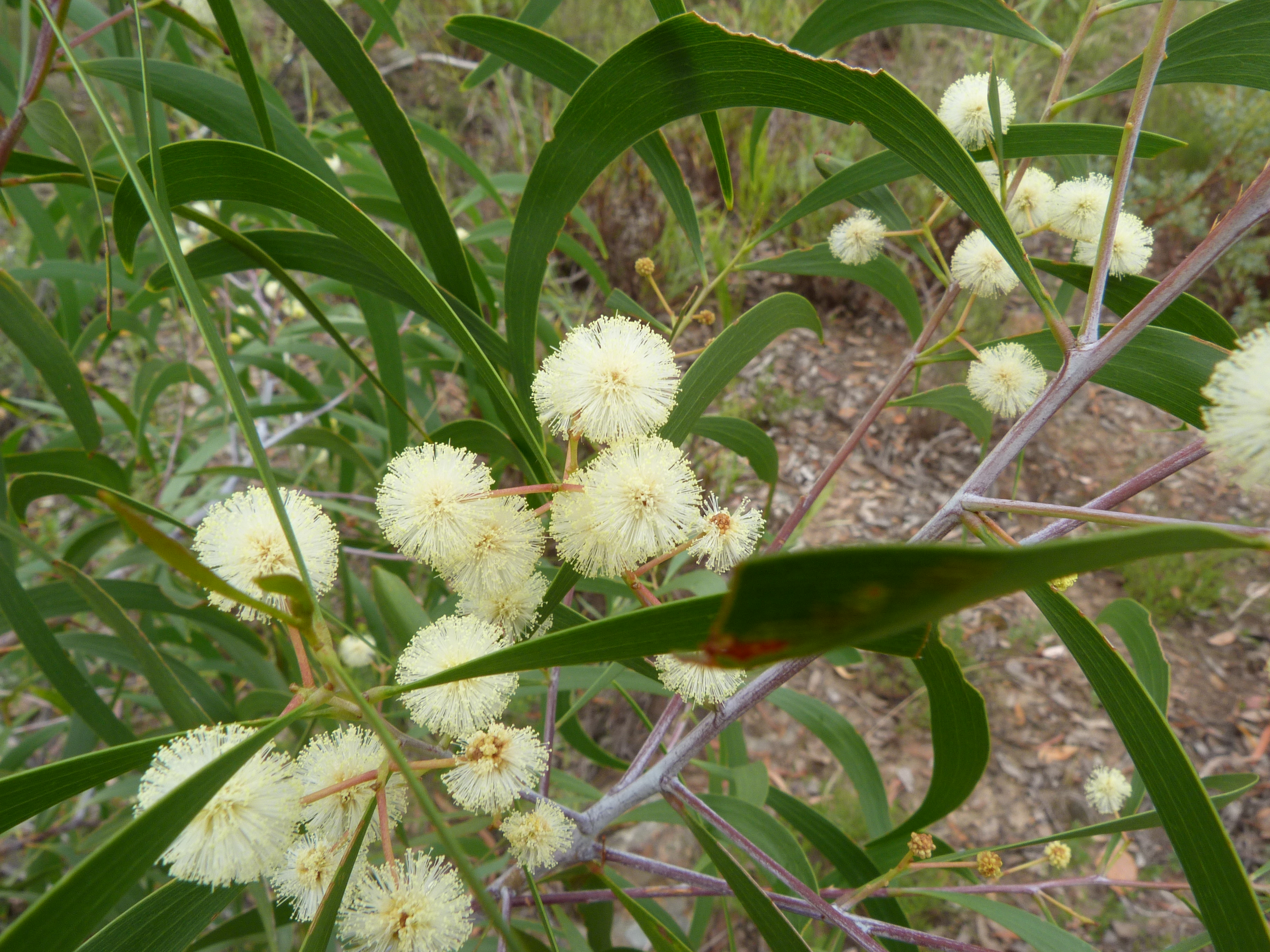
Acacia implexa, commonly known as lightwood or hickory wattle, is a fast-growing Australian tree, the timber of which was used for furniture making. The wood is prized for its finish and strength. The foliage was used to make pulp and dye cloth. The Ngunnawal people of the ACT used the bark to make rope, string, medicine and for fish poison, the timber for tools, and the seeds to make flour.
It is widespread in eastern Australia from central coastal Queensland to southern Victoria, with outlying populations on the Atherton Tableland in northern Queensland and Tasmania's King Island. The tree is commonly found on fertile plains and in hilly country it is usually part of open forest communities and grows in shallow drier sandy and clay soils.
Acacia implexa flowers - photo by Donald Hobern.

Petrophile pulchella, known as conesticks, is a common shrub of the family proteaceae found in eastern Australia. It is found growing on shallow sandstone soils, often in open forest or heathlands near the coast. It is also occasionally seen on the adjacent ranges.
Photo by Selena Griffith, January 18, 2021
Channel-Billed Cuckoos Fledglings 2021
Channel-billed Cuckoos (Scythrops novaehollandiae) have been particularly prolific this year and now their offspring can be seen in the trees - fortunately there seems to be around a gazillion Black Prince cicadas (Psaltoda plaga) to feed them. A pair was seen in Pittwater Spotted Gums at dusk on Monday January 18th 2021 being fed by a pair of Pied Currawongs (Strepera graculina).
Everywhere you look at present there are fledgling birds and most that live on insects seem to be in twin numbers this year - why? Perhaps because there is an abundance of food for insectivorous birds or ??? ...
Marita Macrae (PNHA) tells us; 'This large cuckoo spends our colder months in northern Australia, New Guinea and Indonesia, returning south to breed, arriving in Sydney about the middle of September. A lot of the racket they make is to distract their host birds from attending to their nest, so the female can quickly deposit an egg, or three. Wattlebirds and Currawongs can raise a brood of their own in early spring before these cuckoos arrive, ensuring there will be future hosts. Come the middle of March, adult and juvenile cuckoos head for warmer climes once more.'


Photos by A J Guesdon, January 18, 2021.
The Sydney Edible Garden Trail Gets Physical In 2021
The Sydney Edible Garden Trail is an event aimed at encouraging and inspiring edible gardeners in street gardens, home gardens and public spaces across Sydney.
Backyard growers, school and community gardens, large and small, will be opening their gardens to the public during the weekend of March 20 and 21, 2021, to celebrate the myriad of ways that Sydney residents are creating food security, saving money and the environment, while enjoying the health benefits of home-grown fruit and vegetables.
Costa Georgiadis of ABC Gardening Australia is on board with live feeds from the number of gardens in the lead up to the main event.
We’re on the lookout for private, community and school gardens to register as part of the trail. Gardens can register directly on our website up until 31 January 2021.
Check out some of the gardens already on board the trail - https://sydneyediblegardentrail.com/gardens/
The Trail will be showcasing sustainable practices such as mulching for water conservation, recycling and composting to increase soil fertility and reduce landfill, planting to encourage bees, home food production to increase food security, and organic growing techniques to reduce chemical use.
The Trail will be held over 2 weekends:
- 27-28 February 2021 - A virtual event. Costa Georgiadis, of ABC Gardening Australia will be hosting live feeds from a number of gardens for this virtual event.
- 20-21 March 2021 - A physical self-guided trail with backyard growers, school and community gardens, large and small, opening their gardens to the public.
The Trail is a ticketed event with profits going back into the community in the form of grants to local schools and community groups to support edible gardens. We believe this is a great way to grow and invest in sustainable communities. To see some of the grant recipients from our 2020 event please go to our website: https://sydneyediblegardentrail.com/2020-grant-recipients/
For more info on the background to the event, ticket prices and garden registration, please visit our website: www.sydneyediblegardentrail.com.
Costa and the Team - image supplied
Surfers For Climate
A sea-roots movement dedicated to mobilising and empowering surfers for continuous and positive climate action.
Surfers for Climate are coming together in lineups around the world to be the change we want to see.
With roughly 35 million surfers across the globe, our united tribe has a powerful voice.
Add yours to the conversation by signing up here.
Surfers for Climate will keep you informed, involved and active on both the local and global issues and solutions around the climate crisis via our allies hub.
Help us prevent our favourite spots from becoming fading stories of waves we used to surf.
Together we can protect our oceans and keep them thriving for future generations to create lifelong memories of their own.
Ross River Fever In Pittwater: What You Can Do To Beat Those Mosquitoes
Recent damp and humid weather is bringing out the mozzies, LOTS of mozzies - a reminder that Ross River Fever and Barmah Forest virus are now in our area and there are a few tips you can follow to keep you and your family safe:
1. It is important that if you’re spending a lot of time outdoors in these areas, especially close to wetlands and bush land areas at dawn and dusk when mosquitoes are most active, that you take action to reduce the risk of being bitten. Cover up with long sleeved shirts and long pants and apply an insect repellent. Choose a repellent that contains either DEET (diethlytoluamide), picaridin, or oil of lemon eucalyptus. Apply it to all exposed skin to ensure there is a thin even coat – a dab “here and there” doesn’t provide adequate protection.
2. You can also reduce the incidences of mosquitoes breeding by removing any shallow dishes of water or, if you have these out to feed wildlife and birds, regularly change the water so the stagnant water climate for them to breed is removed. Outbreaks can occur when local conditions of rainfall, tides and temperature promote mosquito breeding, so if we have rain followed by a warm day, check any receptacles in your garden and make sure they are emptied of water.
3. It is also a good idea to ensure you're not being bitten while asleep - repair any flyscreens that are damaged, or install them where absent. There are also a range of plants you can incorporate into your garden that repel mosquitoes and attract mosquito eating insects, such as dragonflies, or birds, possums, frogs and bats that will also reduce their numbers by eating them.
4. Similarly, if you're out and about in our wetland areas not chasing off or disturbing the wildlife that lives there, such as turtles or ducks, with ducklings just a few days old known to eat mosquitoes, will help. They eat them - we need this wildlife.
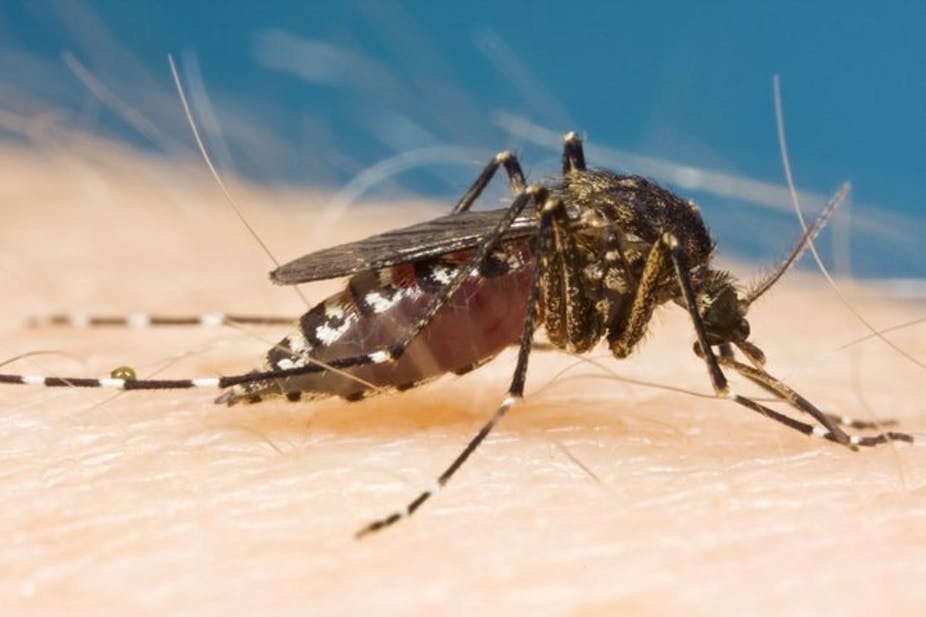
The saltmarsh mosquito, Aedes vigilax, transmits Ross River virus in many coastal regions of Australia. Photo: Mr Stephen Doggett (Medical Entomology, Pathology West - ICPMR Westmead)
Discussion On February 11, 2021: Environmental Issues On Our Northern Beaches
Right now, climate damage and habitat destruction are putting our coasts and communities at risk. From sea level rise and coastal erosion, to land clearing and unsustainable development, our beautiful region faces a number of environmental challenges.
That’s why we’re bringing your local federal Member of Parliament and other experts together to discuss the environmental issues facing Sydney’s Northern Beaches – and how together, we can keep our coasts and communities healthy for generations to come. Will you join us?
What: Healthy coasts, healthy communities: an online panel discussion
When: Thursday 11 February, from 7-8pm AEDT
Where: Online on Zoom. RSVP for the link.
Join our stellar lineup of speakers, including:
- Layne Beachley AO – 7-time world champion surfer and environmental campaigner
- Dr Vanessa Pirotta – wildlife scientist and science communicator
- Jason Falinski MP – federal member for Mackellar
Plus Lynne Malcolm – ABC presenter and former host of All in the Mind podcast – as our MC for the night.
Once you’ve RSVP’d to the event you’ll have an opportunity to submit a question to any of the panel speakers. With such a wealth of knowledge and expertise behind them, we’re sure you’ll have lots to ask!
Hosted by the Australian Conservation Foundation
Upcoming Activities For Friends Of Narrabeen Lagoon Catchment:

Sun 21 February 2021: 7.30 am Walk & Weed along the Narrabeen Lagoon catchment transverse walk.
Start at Oxford Falls walk for 3 1/2 hours, weed for 30min, continue 30min walk and car pool back to start.
Bring gloves and long handled screwdriver if available.
Walk grade: medium.
Bookings essential. Conny 0432 643 295
https://www.narrabeenlagoon.org.au/
Friends of Narrabeen Lagoon Catchment are pleased to announce the next forum will be held on 22 Feb 2021 at 7 pm .
Presenter: Jayden Walsh
Jayden is a keen observer of nature and has some stunning photographs and information to share.
The focus will be on wildlife that lives near the Narrabeen Lagoon and that, if you are fortunate, you may see when on the Narrabeen Lagoon walkway.
For details on how to book for this event are on the website. At: https://www.narrabeenlagoon.org.au/Forums/forums.htm
Bushcare In Pittwater
Where we work Which day What time
Avalon
Angophora Reserve 3rd Sunday 8:30 - 11:30am
Avalon Dunes 1st Sunday 8:30 - 11:30am
Avalon Golf Course 2nd Wednesday 3 - 5:30pm
Careel Creek 4th Saturday 8:30 - 11:30am
Toongari Reserve 3rd Saturday 9 - 12noon (8 - 11am in summer)
Bangalley Headland 2nd Sunday 9 to 12noon
Bayview
Winnererremy Bay 4th Sunday 9 to 12noon
Bilgola
North Bilgola Beach 3rd Monday 9 - 12noon
Algona Reserve 1st Saturday 9 - 12noon
Plateau Park 1st Friday 8:30 - 11:30am
Church Point
Browns Bay Reserve 1st Tuesday 9 - 12noon
McCarrs Creek Reserve Contact Bushcare Officer To be confirmed
Clareville
Old Wharf Reserve 3rd Saturday 8 - 11am
Elanora
Kundibah Reserve 4th Sunday 8:30 - 11:30am
 Mona Vale
Mona Vale Mona Vale Beach Basin 1st Saturday 8 - 11am
Mona Vale Dunes 2nd Saturday +3rd Thursday 8:30 - 11:30am
Newport
Bungan Beach 4th Sunday 9 - 12noon
Crescent Reserve 3rd Sunday 9 - 12noon
North Newport Beach 4th Saturday 8:30 - 11:30am
Porter Reserve 2nd Saturday 8 - 11am
North Narrabeen
Irrawong Reserve 2nd Saturday 2 - 5pm
Palm Beach
North Palm Beach Dunes 3rd Saturday 9 - 12noon
Scotland Island
Catherine Park 2nd Sunday 10 - 12:30pm
Elizabeth Park 1st Saturday 9 - 12noon
Pathilda Reserve 3rd Saturday 9 - 12noon
Warriewood
Warriewood Wetlands 1st Sunday 8:30 - 11:30am
Whale Beach
Norma Park 1st Friday 9 - 12noon
Western Foreshores
Coopers Point, Elvina Bay 2nd Sunday 10 - 1pm
Rocky Point, Elvina Bay 1st Monday 9 - 12noon
Gardens And Environment Groups And Organisations In Pittwater
Pittwater Reserves
Draft Horse Riding Plan For South East Wollemi National Park
The National Parks and Wildlife Service (NPWS) is encouraging people to have their say on proposed horse-riding opportunities in south east Wollemi National Park before submissions close on 14 March 2021.
NPWS Director David Crust said that following strong local community interest over many years, the Service has developed a draft management plan that proposes a number of recreational trails in the Wheeny Creek – Mountain Lagoon area.
“This draft plan proposes how we will assess, rationalise and formalise horse-riding trails in this area,” said Mr Crust.
“There is a long history of horse riding in the Wheeny Creek – Mountain Lagoon area and under this draft plan riders continue to have a strong connection to this landscape.
“We’re proposing to formalise a series of low-impact riding trails that essentially follow existing park management trails.
“Doing so will minimise impacts on threatened species and the conservation values of the area, as well as tie into our existing trail maintenance program.
“The draft plan will ensure we have management arrangements in place to support unique and enjoyable horse-riding opportunities for the community.
“The plan refers only to a 28,000-hectare section of Wollemi National Park, an area in the south east that was not heavily impacted by last summer’s bushfires.
“We welcome feedback on the plan and encourage members of the public and interest groups to make a submission via formal channels so all comments can be recorded and considered,” said Mr Crust.
The public exhibition period for the plan has been extended and submissions now close 14 March 2021.
To read the Draft Horse Riding Management Plan: South East Wollemi National Park and to find out more:
- NPWS Hawkesbury-Nattai Area, Bowmans Cottage, 370 Windsor Street, Richmond – by appointment via email to: npws.hawkesburynattai@environment.nsw.gov.au
- Hawkesbury City Council, 366 George Street, Windsor
- NPWS Glenbrook, end Bruce Road, Glenbrook - by appointment via email to: npws.hawkesburynattai@environment.nsw.gov.au
- Blue Mountains Heritage Centre, end Govetts Leap Road, Blackheath (9.00am to 4.30pm daily)
If you would like to make a submission please follow the instructions via our website.
Improved Access To McBrides Beach In Booti Booti National Park
Visitors can now enjoy a short stroll to the remote and beautiful McBrides Beach in Booti Booti National Park with the completion of a new walking track.
NSW National Parks and Wildlife Service (NPWS) Hunter Central Coast A/Director Anthony Signor said the ever-popular McBrides Beach now has safe pedestrian access from the carpark on Cape Hawke Drive down to the beach.
“The new 600 metre track to the beach, which includes a small number of steps and a watercourse crossing, is suitable for a range of ages and fitness levels,” said Mr Signor.
“Since the track opened in late December, it has been hugely popular with an average of 50 to 100 people using the new track to access the beach each day.
“Following the extreme wet weather over the past few weeks, we have re-surfaced the last 260 metres of the track with gravel, meaning McBrides Beach now has safe, all-weather pedestrian access.
“This work is part of the Government’s $149.6 million ‘Improving Access to National Parks’ program, a state-wide investment to improve national park walking trails to make them safer and more accessible.
“An added benefit of the walking track is better protection for areas of Littoral Rainforest on Cape Hawke, nationally listed as a Critically Endangered Ecological Community, as well as Aboriginal cultural sites occurring in the area around McBrides Beach,” said Mr Signor.
People are reminded to be COVID-19 safe and abide by public health requirements when visiting national parks.
For more information on national park access visit: National Parks and Wildlife Service.

Aerial of McBrides Beach - Image by John Spencer
'Dinosaur Tree' Declared Asset Of Intergenerational Significance (NSW)
The NSW Government has announced the Wollemi pines, in the Blue Mountains World Heritage Area, will be the first site in the State to be declared an Asset of Intergenerational Significance.
The declaration is a legally recognised mechanism to bolster existing measures that protect the species for future generations.
Premier Gladys Berejiklian said the historic declaration recognises the extraordinary global significance of the Wollemi pines, with some of the adult trees estimated to be up to a thousand years old.
"This declaration enables us to take existing protections up another notch, and set specific legislative requirements including a dedicated fire management strategy to secure the survival of the species for generations to come," Ms Berejiklian said.
"Prior to their discovery in 1994, Wollemi pines were only known to us in fossil records with fossil evidence pointing to the species' existence up to 90 million years ago."
Just over 12 months ago, teams from the NSW Rural Fire Service (RFS) and National Parks and Wildlife Service (NPWS) undertook an extensive operation to protect the Wollemis from extinction when the secret site came under threat from the devastating summer bushfires.
The declaration follows a $6 million investment by the NSW Government to embed ecological risk in the fire management framework and bolster bushfire protections for important ecological sites as part of the Government's response to the NSW Bushfire Inquiry.
Environment Minister Matt Kean said the site is the first to be declared under new provisions in the National Parks and Wildlife Act that will enhance conservation for the most precious and rare jewels in our national parks crown.
"The Wollemi pines are often described as a living fossil, having been around when dinosaurs roamed the Earth," Mr Kean said.
"Despite the incredible efforts by the NPWS and RFS teams last summer, several hundred juvenile trees in the protected site were impacted and are yet to resprout.
"That's why we need to act now to put long-term protections in place that reduce the risk of fire exposure and allow the slow-growing juvenile trees to thrive."
The declaration paves the way for special regulations to enhance the Wollemi pines' legal protection including requiring a dedicated fire management strategy, ecological monitoring, and ongoing conservation management.
Other places which will be considered for declaration as Assets of Intergenerational Significance include those containing the most important remaining populations of threatened species, as well as important cultural heritage sites.
See below - from Issue 434, January 2020:
Davidson Rural Fire Brigade's 'Arduous' Firefighters
Davidson Rural Fire Brigade: November 22, 2019
Did you know there is more to firefighting than firetrucks? In addition to deploying crews on trucks, today we also deployed a crew of 4 ‘Arduous’ certified volunteer firefighters to the Gospers Mountain fire, north west of Sydney. These crews use firefighting techniques without water, in areas usually only accessible by foot or helicopter insertion.
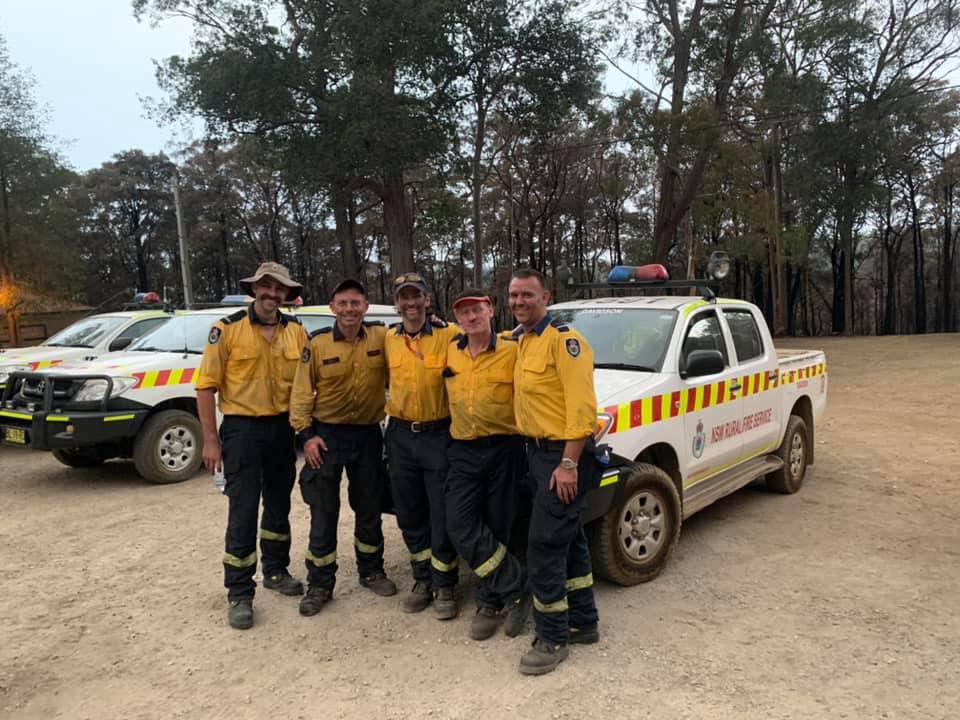
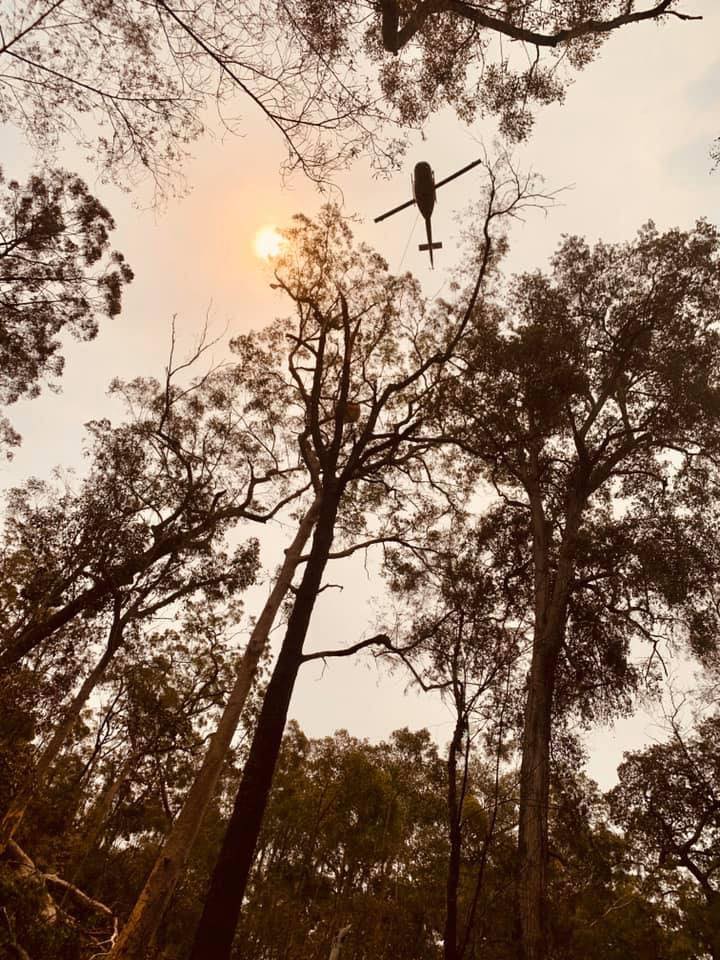
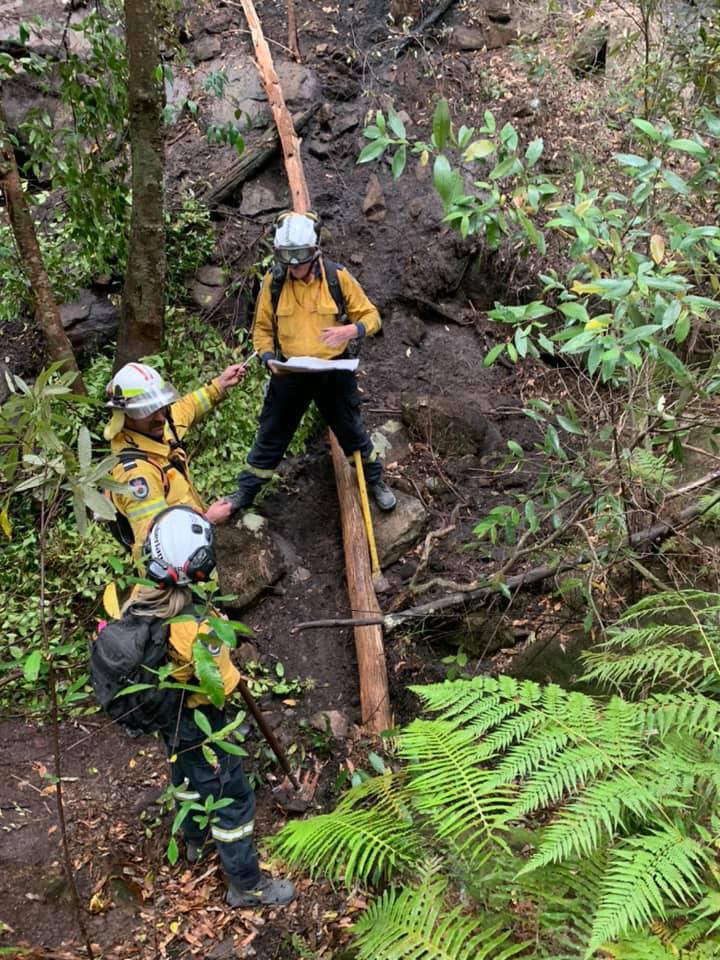
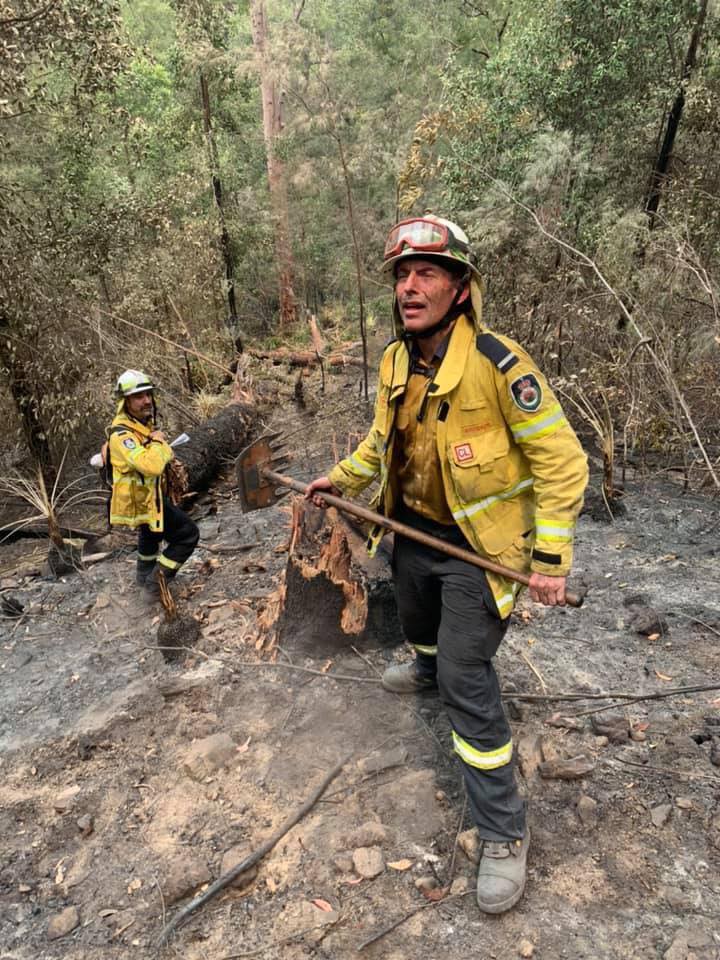
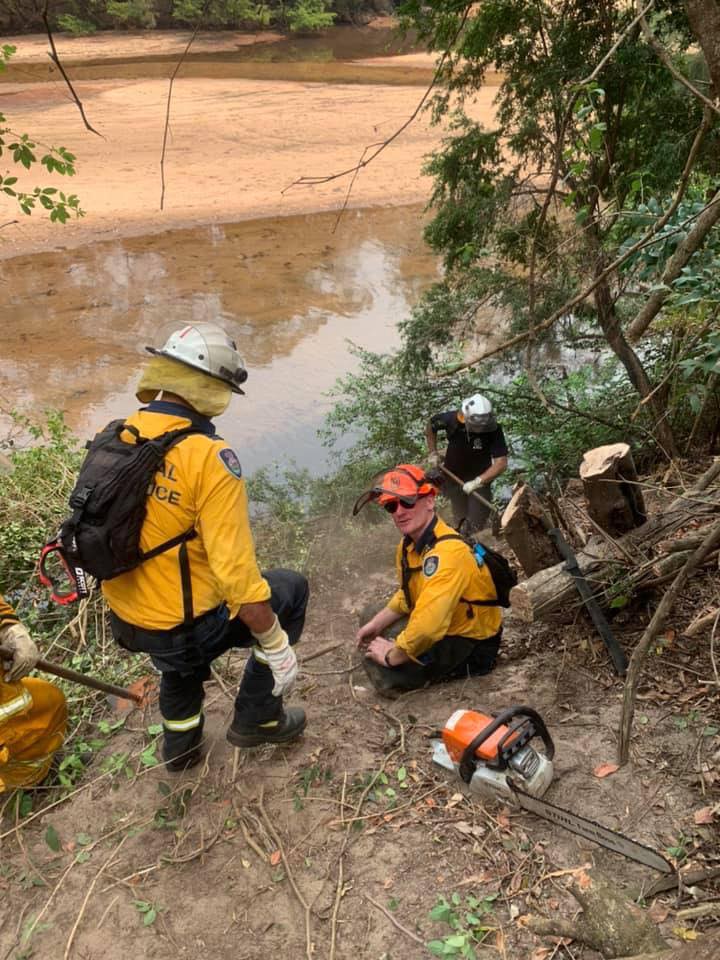
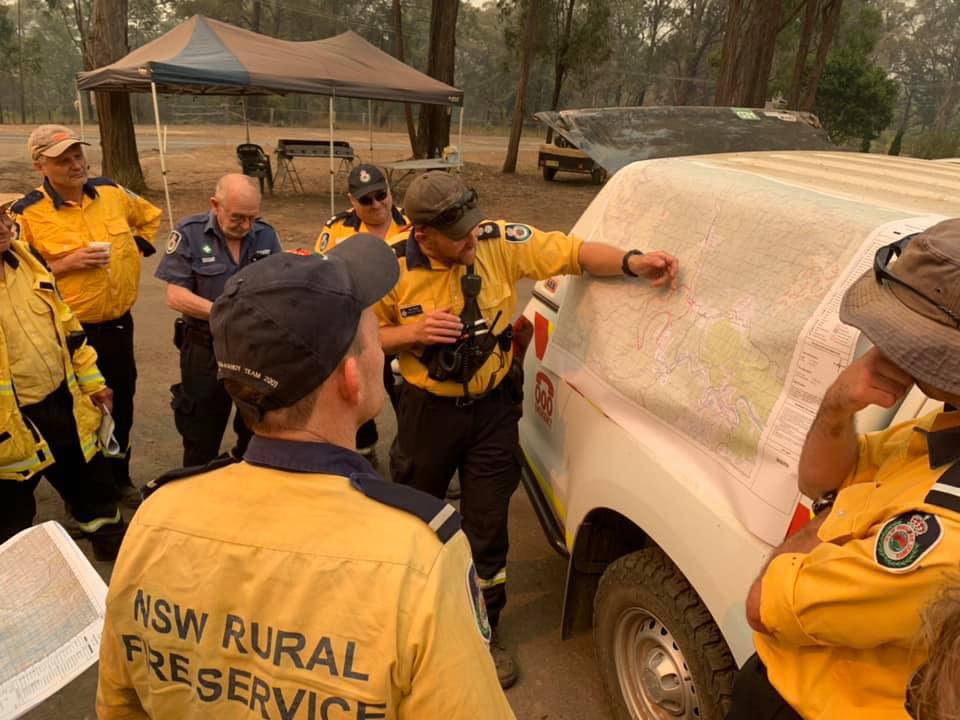
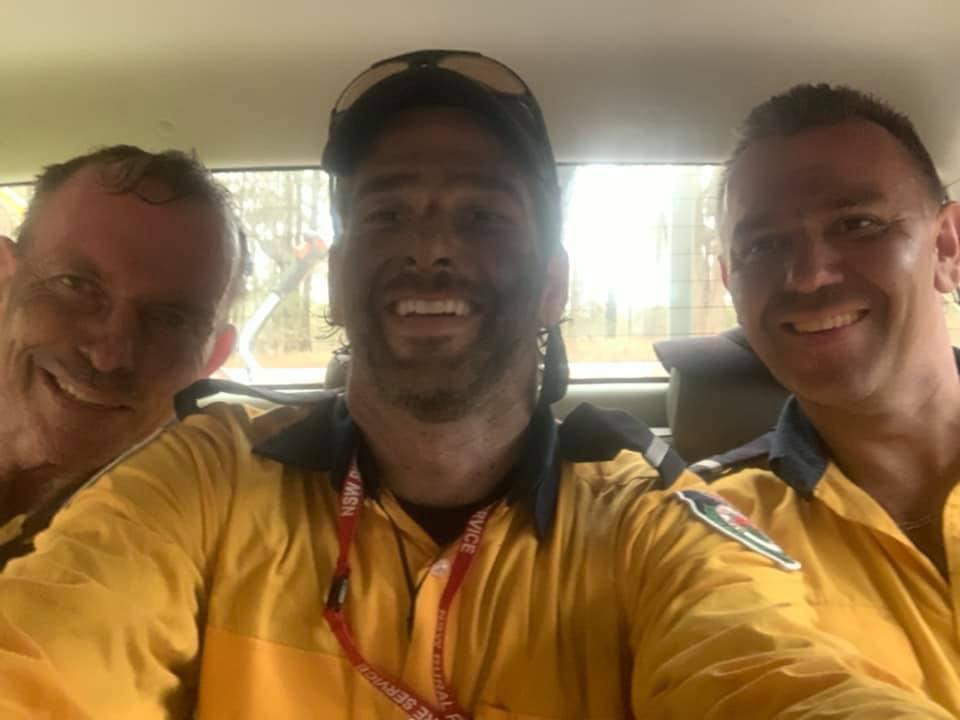
Fire Fighting Mission Saves Prehistoric Pines
January 15, 2020: NSW Government, Department of Environment
A specialist team of remote area firefighters have helped to save the prehistoric Wollemi Pines from this season’s bushfires, confirmed Environment Minister Matt Kean.
Mr Kean said the Wollemi Pines survived the dinosaurs and now they look like they’ll survive these bushfires thanks to the work of the NSW National Parks and Wildlife Service (NPWS) firefighters and the NSW Rural Fire Service.
“Wollemi National Park is the only place in the world where these trees are found in the wild and, with less than 200 left, we knew we needed to do everything we could to save them,” Mr Kean said.
“The pines, which prior to 1994 were thought to be extinct and whose location is kept secret to prevent contamination, benefited from an unprecedented environmental protection mission.”
The operation included large air tankers laying fire retardant and specialist firefighters being winched into the remote site from helicopters to set up an irrigation system in the gorge to increase moisture content of the ground fuels.
In advance of the fire, NPWS firefighters were again winched into the site to operate the irrigation system and as the fire approached, helicopters water bucketed the fire edge to reduce its impact on the groves of trees.
Mr Kean said the NSW Government has done a detailed scientific assessment and, while some trees are charred, the species has survived this summer’s fires.
“The 2019 wildfire is the first ever opportunity to see the fire response of mature Wollemi Pine in a natural setting, which will help us refine the way we manage fire in these sites long-term.”
Mr Kean said the full impact of the fire may not be known for some time so we need to do everything we can to ensure their long-term protection which really depends on maintaining confidentiality around the trees’ location and ensuring the public’s cooperation in not attempting to visit the sites.
“Illegal visitation remains a significant threat to the Wollemi Pines survival in the wild due to the risk of trampling regenerating plants and introducing diseases which could devastate the remaining populations and their recovery.
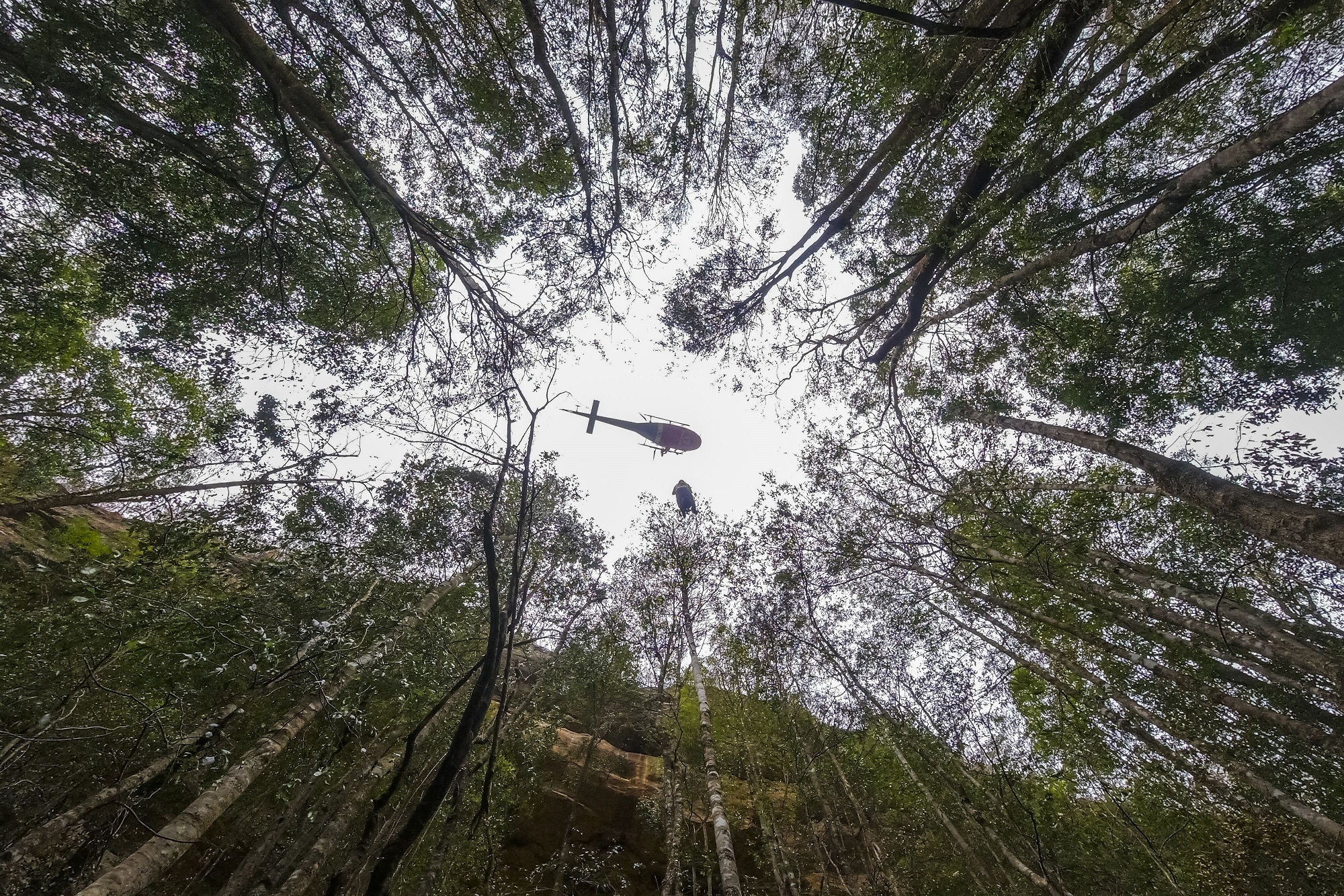
Wollemi pine (Wollemia nobilis) trees savers - Photo: J Plaza/DPIE
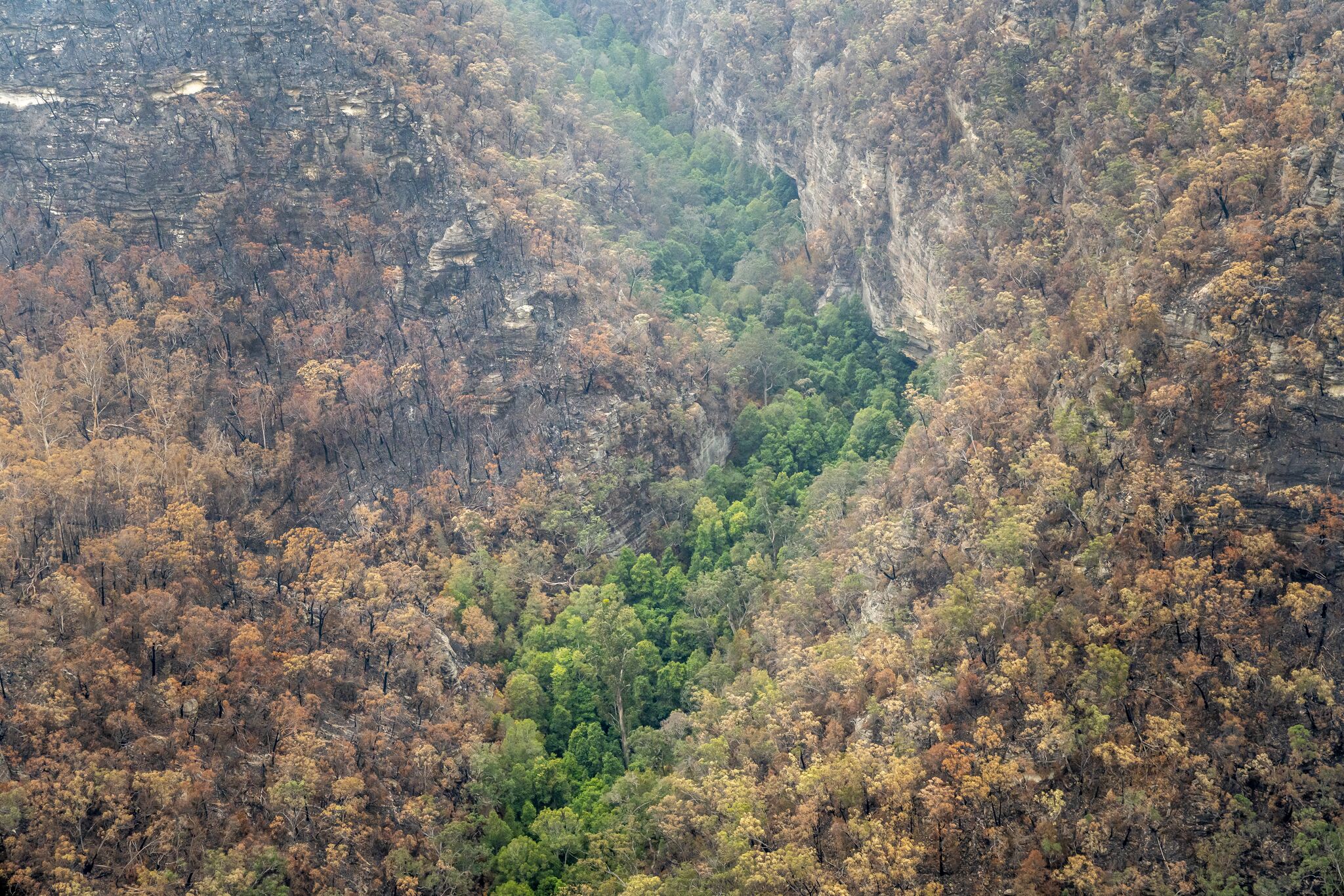
Wollemi pine (Wollemia nobilis) trees savers - Photo: J Plaza/DPIE
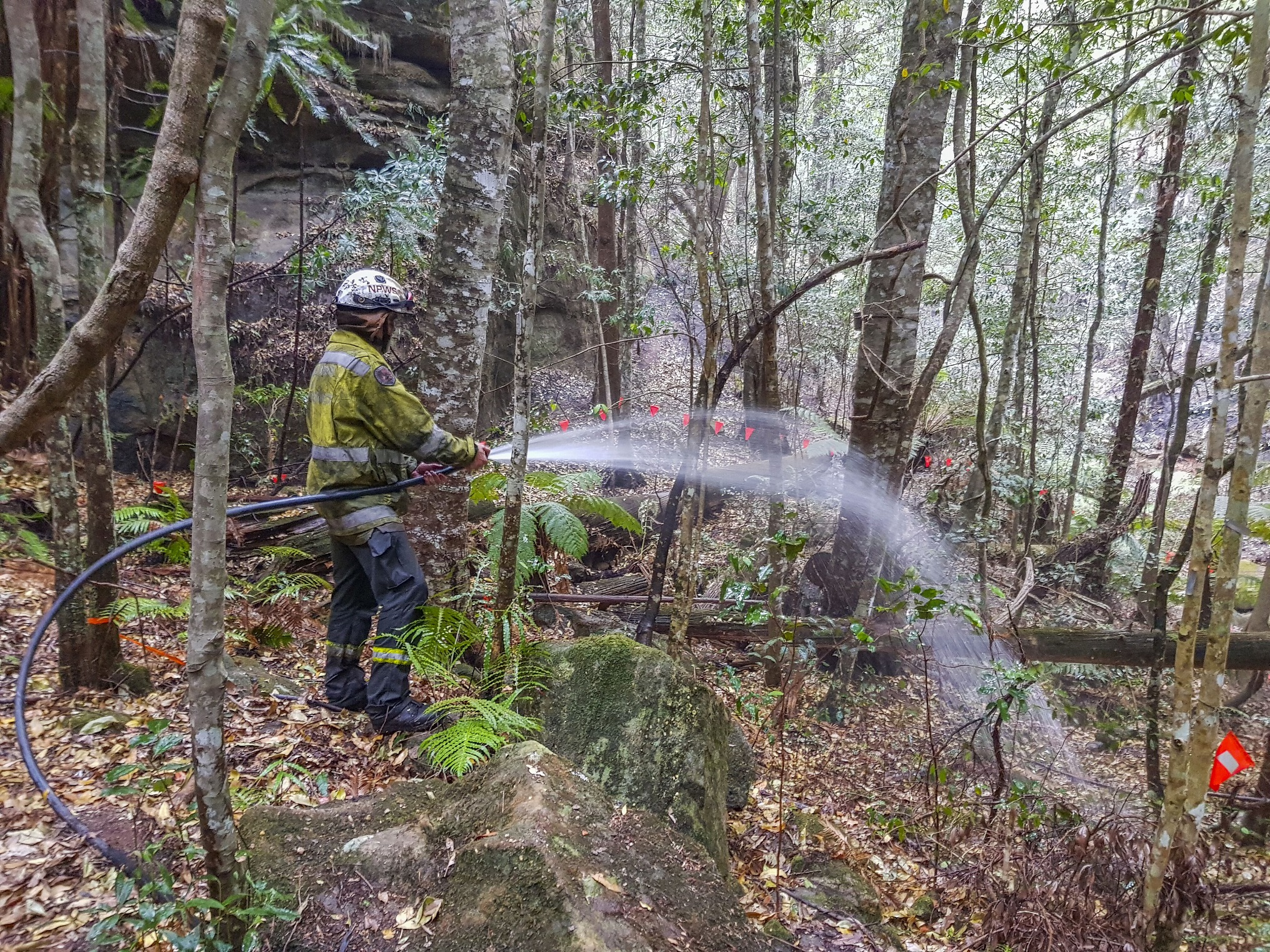
Wollemi pine (Wollemia nobilis) trees savers - Photo: J Plaza/DPIE
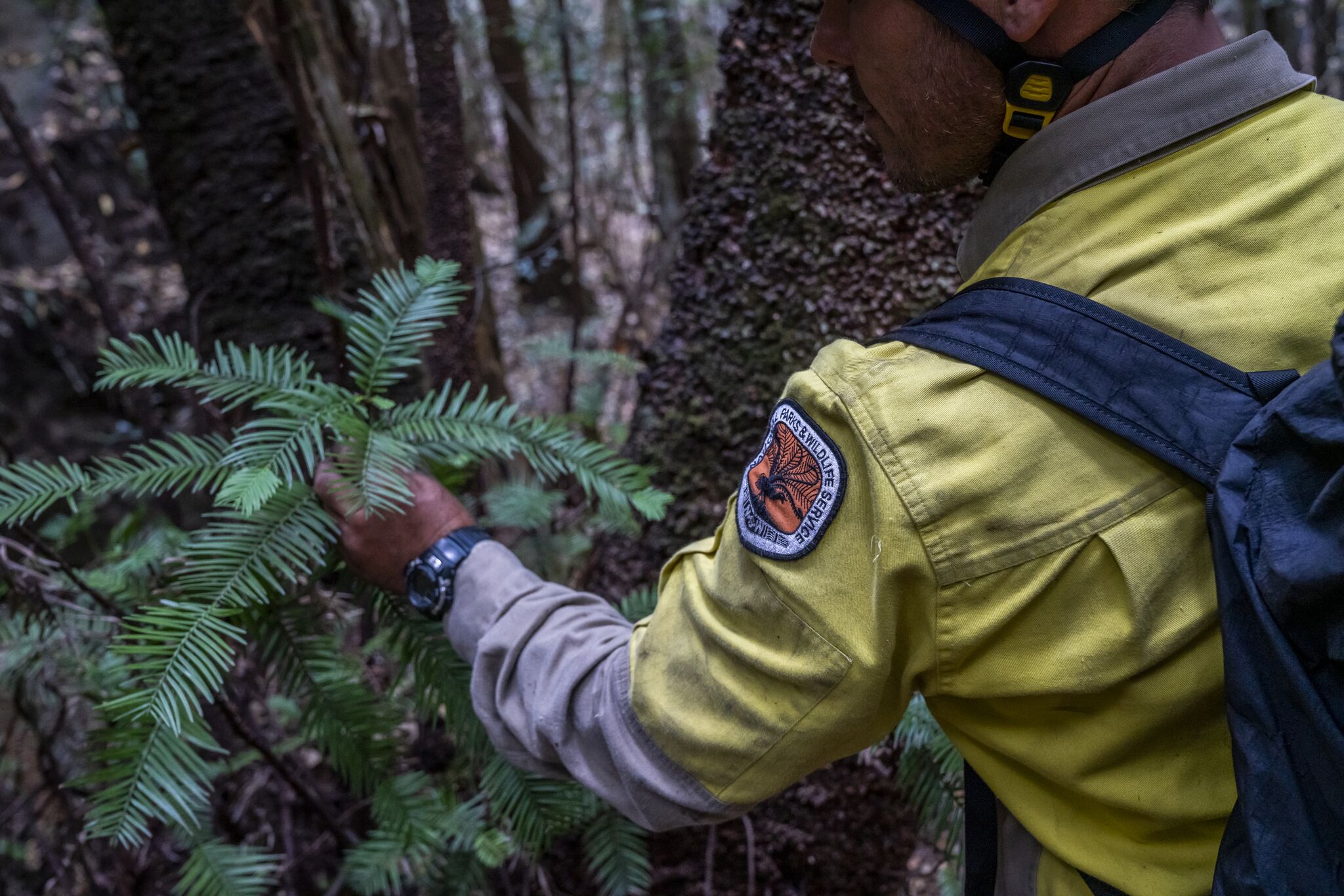
Wollemi pine (Wollemia nobilis) trees savers - Photo: J Plaza/DPIE
It's not too late to save them: 5 ways to improve the government's plan to protect threatened wildlife
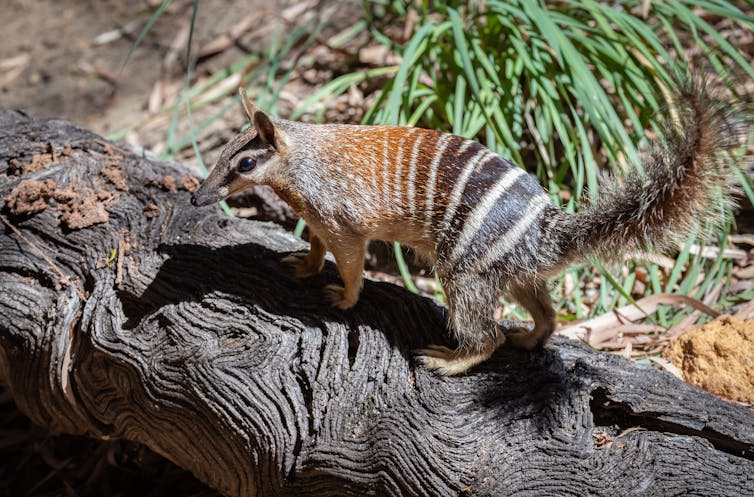
Australia’s Threatened Species Strategy — a five-year plan for protecting our imperilled species and ecosystems — fizzled to an end last year. A new 10-year plan is being developed to take its place, likely from March.
It comes as Australia’s list of threatened species continues to grow. Relatively recent extinctions, such as the Christmas Island forest skink, Bramble Cay melomys and smooth handfish, add to an already heavy toll.
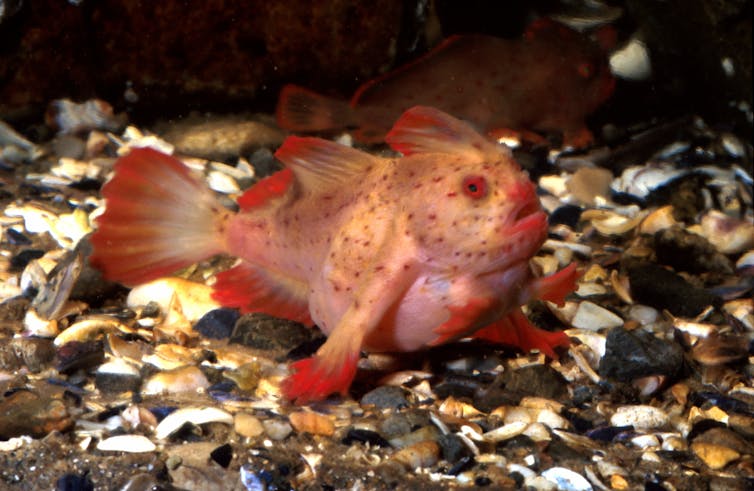
Now, more than ever, Australia’s remarkable species and environments need strong and effective policies to strengthen their protection and boost their recovery.
So as we settle into the new year, let’s reflect on what’s worked and what must urgently be improved upon, to turn around Australia’s extinction crisis.
How Effective Was The First Threatened Species Strategy?
The Threatened Species Strategy is a key guiding document for biodiversity conservation at the national level. It identifies 70 priority species for conservation, made up of 20 birds, 20 mammals and 30 plants, such as the plains-wanderer, malleefowl, eastern quoll, greater bilby, black grevillea and Kakadu hibiscus.
These were considered among the most urgent in need of assistance of the more than 1,800 threatened species in Australia.
The strategy also identifies targets such as numbers of feral cats to be culled, and partnerships across industry, academia and government key to making the strategy successful.
The original strategy (2015-20) was eagerly welcomed for putting the national spotlight on threatened species conservation. It has certainly helped raise awareness of its priority species.
However, there’s little evidence the strategy has had a significant impact on threatened species conservation to date.
The midterm report in 2019 found only 35% of the priority species (14 in total) had improving trajectories compared to before the strategy (pre-2015). This number included six species — such as the brush-tailed rabbit-rat and western ringtail possum — that were still declining, but just at a slower rate.

On average, the trends of threatened mammal and bird populations across Australia are not increasing.
Other targets, such as killing two million feral cats by 2020, were not explicitly linked to measurable conservation outcomes, such as an increase in populations of threatened native animals. Because of this, it’s difficult to judge their success.
Read more: Feral cat cull: why the 2 million target is on scientifically shaky ground
What Needs To Change?
The previous strategy focused very heavily on feral cats as a threat and less so on other important and potentially compounding threats, particularly habitat destruction and degradation.
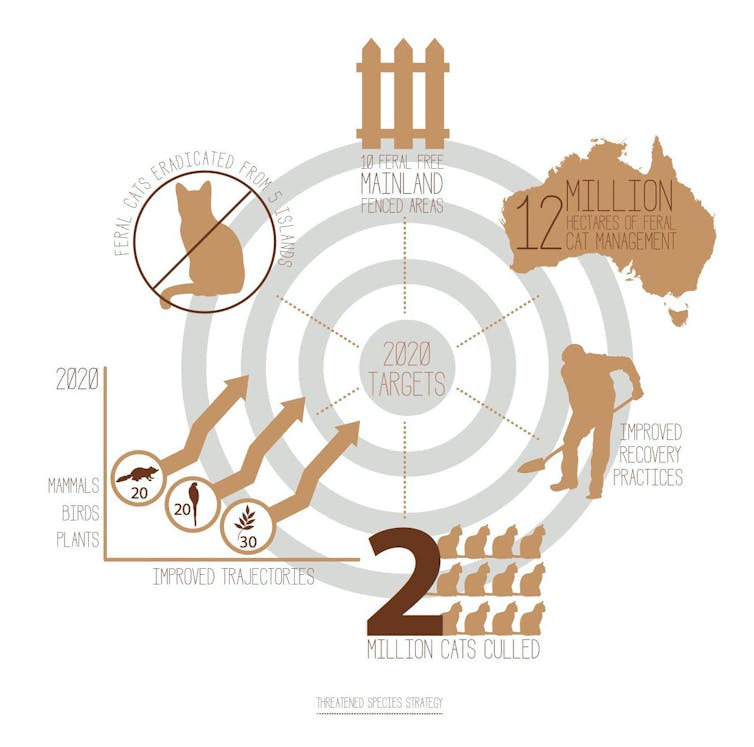
For instance, land clearing has contributed to a similar number of extinctions in Australia (62 species) as introduced animals such as feral cats (64).
In fact, 2018 research found agricultural activities affect at least 73% of invertebrates, 82% of birds, 69% of amphibians and 73% of mammals listed as threatened in Australia. Urban development and climate change threaten up to 33% and 56% of threatened species, respectively.
Other important threats to native Australian species include pollution, feral herbivores (such as horses and goats), very frequent or hot bushfires and weeds. Buffel grass was recently identified as a major emerging threat to Australia’s biodiversity, with the risk being as high as the threat posed by cats and foxes.
Five Vital Improvements
We made a submission to the Morrison government when the Threatened Species Strategy was under review. Below, we detail our key recommendations.
1. A holistic and evidence-based approach encompassing the full range of threats
This includes reducing rates of land clearing — a major and ongoing issue, but largely overlooked in the previous strategy.
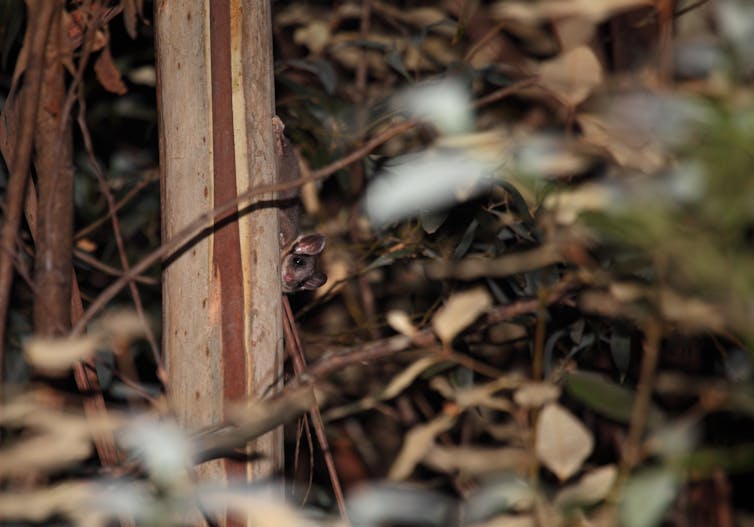
2. Formal prioritisation of focal species, threats and actions
The previous strategy focused heavily on a small subset of the more than 1,800 threatened species and ecosystems in Australia. It mostly disregarded frog, reptile, fish and invertebrate species also threatened with extinction.
To reduce bias towards primarily “charismatic” species, the federal government should use an evidence-based prioritisation approach, known as “decision science”, like they do in New South Wales, New Zealand and Canada. This would ensure funds are spent on the most feasible and beneficial recovery efforts.
3. Targets linked to clear and measurable conservation outcomes
Some targets in the first Threatened Species Strategy were difficult to measure, not explicitly linked to conservation outcomes, or weak. Targets need to be more specific.
For example, a target to “improve the trajectory” of threatened species could be achieved if extinction is occurring at a slightly slower rate. Alternatively, a target to “improve the conservation status” of a species is achieved if new assessments rate it as “vulnerable” rather than “endangered”.
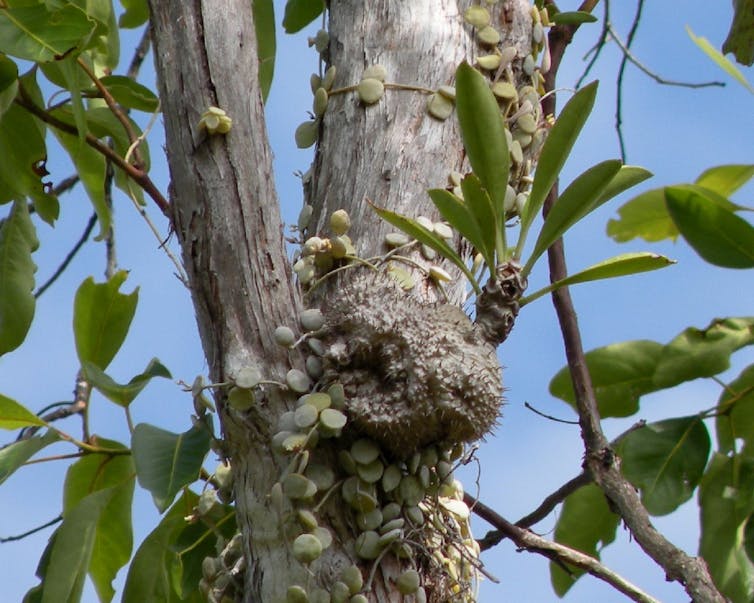
4. Significant financial investment from government
Investing in conservation reduces biodiversity loss. A 2019 study found Australia’s listed threatened species could be recovered for about A$1.7 billion per year. This money could be raised by removing harmful subsidies that directly threaten biodiversity, such as those to industries emitting large volumes of greenhouse gases.
The first strategy featured a call for co-investment from industry. But this failed to attract much private sector interest, meaning many important projects aimed at conserving species did not proceed.
5. Government leadership, coordination and policy alignment
The Threatened Species Strategy should be aligned with Australia’s international obligations such as the United Nation’s Sustainable Development Goals and the federal Environment Protection and Biodiversity Conservation Act 1999 (which is also currently being reviewed). This will help foster a more coherent and efficient national approach to threatened species conservation.
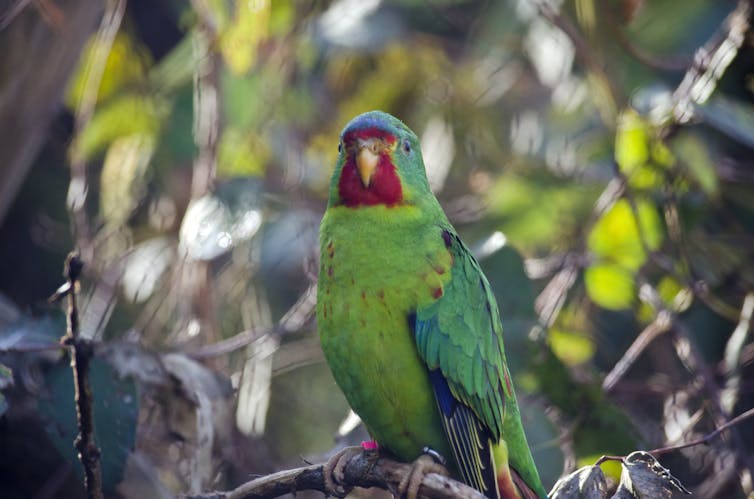
There are also incredible opportunities to better align threatened species conservation with policies and investment in climate change mitigation and sustainable agriculture.
The benefits of investing heavily in wildlife reach beyond preventing extinctions. It would generate many jobs, including in regional and Indigenous communities.
Protecting our natural heritage is an investment, not a cost. Now is the time to seize this opportunity.
Read more: Scientists re-counted Australia's extinct species, and the result is devastating ![]()
Euan Ritchie, Professor in Wildlife Ecology and Conservation, Centre for Integrative Ecology, School of Life & Environmental Sciences, Deakin University; Ayesha Tulloch, DECRA Research Fellow, University of Sydney; Don Driscoll, Professor in Terrestrial Ecology, Deakin University; Megan C Evans, Lecturer and ARC DECRA Fellow, UNSW, and Tim Doherty, ARC DECRA Fellow, University of Sydney
This article is republished from The Conversation under a Creative Commons license. Read the original article.
Engineers have built machines to scrub CO₂ from the air. But will it halt climate change?
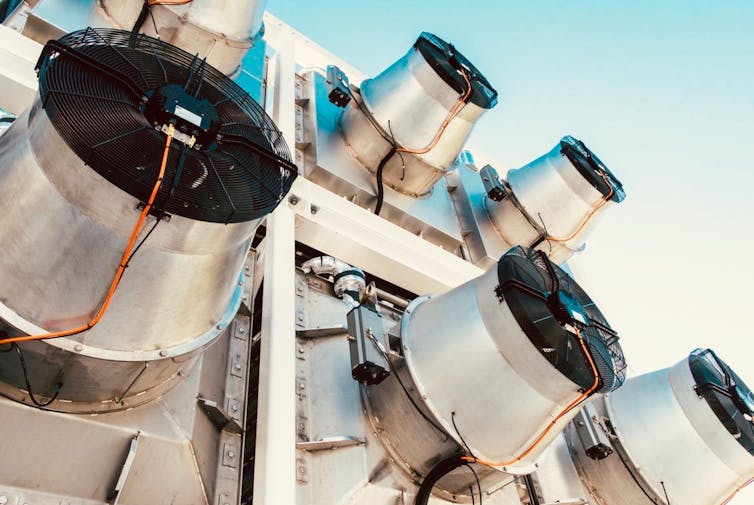
On Wednesday this week, the concentration of carbon dioxide in the atmosphere was measured at at 415 parts per million (ppm). The level is the highest in human history, and is growing each year.
Amid all the focus on emissions reduction, the Intergovernmental Panel on Climate Change (IPCC) says it will not be enough to avoid dangerous levels of global warming. The world must actively remove historical CO₂ already in the atmosphere - a process often described as “negative emissions”.
CO₂ removal can be done in two ways. The first is by enhancing carbon storage in natural ecosystems, such as planting more forests or storing more carbon in soil. The second is by using direct air capture (DAC) technology that strips CO₂ from the ambient air, then either stores it underground or turns it into products.
US research published last week suggested global warming could be slowed with an emergency deployment of a fleet of “CO₂ scrubbers” using DAC technology. However a wartime level of funding from government and business would be needed. So is direct air capture worth the time and money?

What’s DAC All About?
Direct air capture refers to any mechanical system capturing CO₂ from the atmosphere. Plants operating today use a liquid solvent or solid sorbent to separate CO₂ from other gases.
Swiss company Climeworks operates 15 direct air capture machines across Europe, comprising the world’s first commercial DAC system. The operation is powered by renewable geothermal energy or energy produced by burning waste.
The machines use a fan to draw air into a “collector”, inside which a selective filter captures CO₂. Once the filter is full, the collector is closed and the CO₂ is sequestered underground.
Read more: Net-zero, carbon-neutral, carbon-negative ... confused by all the carbon jargon? Then read this
Canadian company Carbon Engineering uses giant fans to pull air into a tower-like structure. The air passes over a potassium hydroxide solution which chemically binds to the CO₂ molecules, and removes them from the air. The CO₂ is then concentrated, purified and compressed.
Captured CO₂ can be injected into the ground to extract oil, in some cases helping to counteract the emissions produced by burning the oil.
The proponents of the Climeworks and Carbon Engineering technology say their projects are set for large-scale investment and deployment in coming years. Globally, the potential market value of DAC technology could reach US$100bn by 2030, on some estimates.
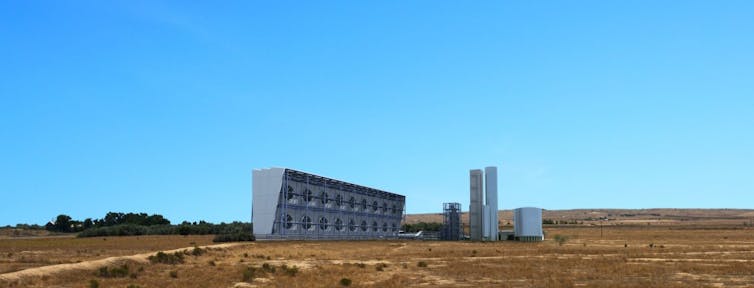
Big Challenges Ahead
Direct air capture faces many hurdles and challenges before it can make a real dent in climate change.
DAC technology is currently expensive, relative to many alternative ways of capturing CO₂, but is expected to become cheaper as the technology scales up. The economic feasibility will be helped by the recent emergence of new carbon markets where negative emissions can be traded.
DAC machines process an enormous volume of air, and as such are very energy-intensive. In fact, research has suggested direct air capture machines could use a quarter of global energy in 2100. However new DAC methods being developed could cut the technology’s energy use.
Read more: The Morrison government wants to suck CO₂ out of the atmosphere. Here are 7 ways to do it
While the challenges to direct air capture are great, the technology uses less land and water than other negative emissions technologies such as planting forests or storing CO₂ in soils or oceans.
DAC technology is also increasingly gaining the backing of big business. Microsoft, for example, last year included the technology in its carbon negative plan.
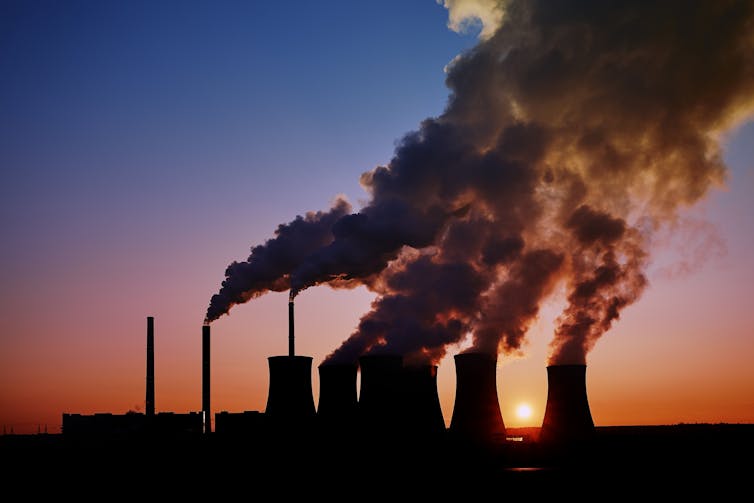
Opportunities For Australia
Australia is uniquely positioned to be a world leader in direct air capture. It boasts large areas of land not suitable for growing crops. It has ample sunlight, meaning there is great potential to host DAC facilities powered by solar energy. Australia also has some of the world’s best sites in which to “sequester” or store carbon in underground reservoirs.
Direct air capture is a relatively new concept in Australia. Australian company Southern Green Gas, as well as the CSIRO, are developing solar-powered DAC technologies. The SGG project, with which I am involved, involves modular units potentially deployed in large numbers, including close to sites where captured CO₂ can be used in oil recovery or permanently stored.
If DAC technology can overcome its hurdles, the benefits will extend beyond tackling climate change. It would create a new manufacturing sector and potentially re-employ workers displaced by the decline of fossil fuels.
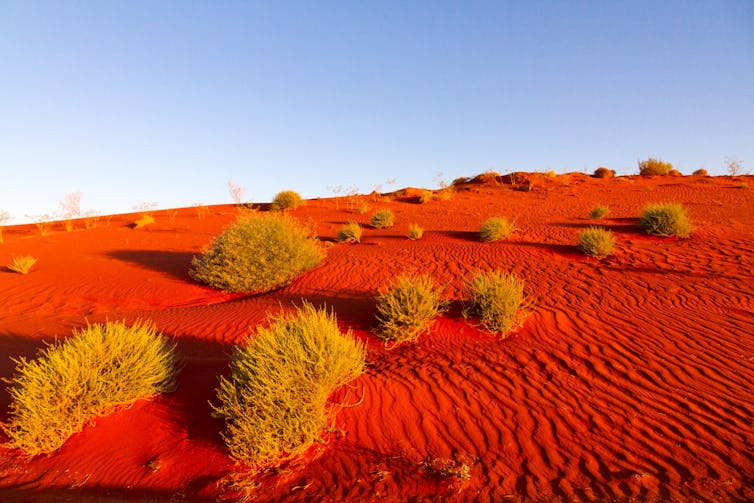
Looking Ahead
The urgency of removing CO₂ from the atmosphere seems like an enormous challenge. But not acting will bring far greater challenges: more climate and weather extremes, irreversible damage to biodiversity and ecosystems, species extinction and threats to health, food, water and economic growth.
DAC technology undoubtedly faces stiff headwinds. But with the right policy incentives and market drivers, it may be one of a suite of measures that start reversing climate change.
Read more: Earth may temporarily pass dangerous 1.5℃ warming limit by 2024, major new report says ![]()
Deanna D'Alessandro, Professor & ARC Future Fellow, University of Sydney
This article is republished from The Conversation under a Creative Commons license. Read the original article.
 Shorebird Identification Booklet
Shorebird Identification Booklet
The Migratory Shorebird Program has just released the third edition of its hugely popular Shorebird Identification Booklet. The team has thoroughly revised and updated this pocket-sized companion for all shorebird counters and interested birders, with lots of useful information on our most common shorebirds, key identification features, sighting distribution maps and short articles on some of BirdLife’s shorebird activities.
The booklet can be downloaded here in PDF file format: http://www.birdlife.org.au/documents/Shorebird_ID_Booklet_V3.pdf
Paper copies can be ordered as well, see http://www.birdlife.org.au/projects/shorebirds-2020/counter-resources for details.
Download BirdLife Australia's children’s education kit to help them learn more about our wading birdlife
Shorebirds are a group of wading birds that can be found feeding on swamps, tidal mudflats, estuaries, beaches and open country. For many people, shorebirds are just those brown birds feeding a long way out on the mud but they are actually a remarkably diverse collection of birds including stilts, sandpipers, snipe, curlews, godwits, plovers and oystercatchers. Each species is superbly adapted to suit its preferred habitat. The Red-necked Stint is as small as a sparrow, with relatively short legs and bill that it pecks food from the surface of the mud with, whereas the Eastern Curlew is over two feet long with a exceptionally long legs and a massively curved beak that it thrusts deep down into the mud to pull out crabs, worms and other creatures hidden below the surface.
Some shorebirds are fairly drab in plumage, especially when they are visiting Australia in their non-breeding season, but when they migrate to their Arctic nesting grounds, they develop a vibrant flush of bright colours to attract a mate. We have 37 types of shorebirds that annually migrate to Australia on some of the most lengthy and arduous journeys in the animal kingdom, but there are also 18 shorebirds that call Australia home all year round.
What all our shorebirds have in common—be they large or small, seasoned traveller or homebody, brightly coloured or in muted tones—is that each species needs adequate safe areas where they can successfully feed and breed.
The National Shorebird Monitoring Program is managed and supported by BirdLife Australia.
This project is supported by Glenelg Hopkins Catchment Management Authority and Hunter Local Land Services through funding from the Australian Government’s National Landcare Program. Funding from Helen Macpherson Smith Trust and Port Phillip Bay Fund is acknowledged.
The National Shorebird Monitoring Program is made possible with the help of over 1,600 volunteers working in coastal and inland habitats all over Australia.
The National Shorebird Monitoring program (started as the Shorebirds 2020 project initiated to re-invigorate monitoring around Australia) is raising awareness of how incredible shorebirds are, and actively engaging the community to participate in gathering information needed to conserve shorebirds.
In the short term, the destruction of tidal ecosystems will need to be stopped, and our program is designed to strengthen the case for protecting these important habitats.
In the long term, there will be a need to mitigate against the likely effects of climate change on a species that travels across the entire range of latitudes where impacts are likely.
The identification and protection of critical areas for shorebirds will need to continue in order to guard against the potential threats associated with habitats in close proximity to nearly half the human population.
Here in Australia, the place where these birds grow up and spend most of their lives, continued monitoring is necessary to inform the best management practice to maintain shorebird populations.
BirdLife Australia believe that we can help secure a brighter future for these remarkable birds by educating stakeholders, gathering information on how and why shorebird populations are changing, and working to grow the community of people who care about shorebirds.
To find out more visit: http://www.birdlife.org.au/projects/shorebirds-2020/shorebirds-2020-program
Aussie Bread Tags Collection Points

Express Yourself Exhibition 2021
The talent and creativity of more than 40 HSC Visual Art students on the Northern Beaches will be on display for the annual Express Yourself exhibition at the Manly Art Gallery & Museum (MAG&M) from February 19th until March 28th 2021.
The winners of the $3,000 Manly Art Gallery & Museum Society Youth Art Award and $5,000 Theo Batten Bequest Youth Art Award will be announced on Friday 19th of February. These two awards are granted annually to students featured in the exhibition.
Artist statements will be displayed alongside the artworks describing the inspirations and influences that informed the works and the students’ creative journeys.
Visitors are encouraged to vote for their favourite artwork in the KALOF People’s Choice Award which is announced at the end of the exhibition period.
Express Yourself is also part of Art Month Sydney, March 2021.
Exhibition: 19 February - Sunday 28 March 2021, 10am - 4pm daily (excluding Mondays)
Teachers' preview: Friday 19 February, 5 - 6pm. Bookings essential via Council’s website
Art Walk and Talk: Saturday 27 February, 3 – 4pm: Artists walk through the exhibition and discuss their works with the curator. Bookings essential via Council’s website.


Winter Sports 2021 Registrations
Netball
Narrabeen Youth Club - Netball
NYC (Narrabeen Youth Club) Netball is a local family-oriented netball club for U8's to Senior players, with competition running through winter on a Saturday at John Fisher Netball Courts in Curl Curl.
All details on how to register are available on our website: https://www.nycnetball.com.au/
Mona Vale Commodores Netball Club
Register for our Come and Try Netball Day on Saturday 23rd January from 10:30-12pm. Session will be held at New Life Gym at 10 Jubilee Ave, Warriewood. Ideal for kids aged 5-12 years. Please book your child’s free ticket at www.trybooking.com/BNMSC
Local family friendly netball club based on the Northern Beaches of Sydney catering for all levels from NetSetGo to Seniors. Live local, play local. Established in 1969.
To register visit: http://www.monavale.nsw.netball.com.au/
Newport Breakers Netball Club
Visit: https://www.facebook.com/newportnetball
Email: newportbreakersnetball@gmail.com
Pittwater Peninsula Netball Club
Online registrations are now open!! Go to www.peninsulanetball.org.au and follow the links.
Tips before you start:
- have your MyNetball details handy (if unsure or applying for the first time visit mynetball.resultsvault.com)
- if you would like to use the 2021 Active Kids Voucher visit http://www.service.nsw.gov.au/.../apply-active-kids-voucher
- once you have your MyNetball number and your Active Kids Voucher head to our website and click on Register then follow the prompts.
Baseball
Pittwater Baseball Club
Pittwater Baseball Club has been part of the community for over 35 years and has a great reputation. Our club has seen many families through from Ratpackers (4-6 yr olds) to Adult Senior Leagues (16+), plus Masters and Minor Leagues over summer and winter. We are about having fun with friends, Making new ones, learning good sportsmanship, developing skills and making memories... Our home field is Rat Park in Warriewood and we are part of the Manly Warringah Baseball Association.
So come join us and have a go.
Junior Rugby League
Mona Vale Raiders
16 Bishop Street, Newport
The Mona Vale Raiders are one of the fastest growing and one of the most successful junior rugby league clubs in the Manly Warringah competition. Our home ground is Newport Oval, which is located between Bishop St and Barrenjoey Rd. Our club is a family club and as such we have a policy of giving all young people who are interested in playing rugby league a fair go. This emphasis has allowed us to be one of the most successful clubs in the Manly Warringah Junior Rugby League competition. The suburbs we cover are Mona Vale, Newport, Warriewood, Ingelside, Bayview, Church Point and Scotland Island. For more information please contact registrar@monavalerugbyleague.com.au
Narrabeen Sharks
In 2021 we will celebrate our 89th season. As the oldest and biggest club on the peninsular we have a long tradition of producing Junior Representative, First Grade and Australian Representative players. We have teams for every age group from Under 6s to Under 20s as well as Open Age A Grade and Over 35s Masters where we have players in their 60s. We are a community based club with a strong focus on family and inclusion. Our values are Honour, Respect, Loyalty, Integrity and Teamwork. Most of all we have FUN while developing our skills under qualified coaches in a safe environment. We accept Active Kids Vouchers so have your details ready. Come and make some lifelong friends while you play the greatest game of all with the Narrabeen Sharks. Email: sharksregistrar2101@gmail.com
Avalon Bulldogs
Avalon Bulldogs Junior Rugby League Club fields teams from Under 6's through to Open Age within the Manly Warringah District and NSW Northern Conference Competitions. Email: sambaum@optusnet.com.au
Junior Rugby Union
Newport Junior Rugby Club
We welcome registrations from kids of all abilities and all ages from U6 to U18.
To register your children to play for Newport Rugby Club, you will need to set up your MyRugby account and register your children online following the steps here.
If you have any questions with regards to your registration, please contact our registrar or one of your age managers ( details in our committee tab ).
Important Note: Register for “Newport Junior Rugby” not Newport Rugby which is the senior rugby club! For any u10 players and above you will need to upload a photo for match day records.
More at: https://www.newportjuniorrugby.com.au/registration/
Narrabeen Tigers Junior Rugby Club
Narrabeen Tigers Rugby is a family club that prides itself on providing a safe and happy atmosphere where boys and girls can play rugby with their mates and learn some great new skills along the way. We are affiliated with Warringah Junior Rugby Union, and are located adjacent to Warringah Seniors rugby (Pittwater Rugby Park) at North Narrabeen Reserve, North Narrabeen.
We have over 300 registered players, all the way from under 6 to under 17 year olds. We are also very proud to have grown the girls teams in our club. Girls of any age are welcome to play in mixed teams, however for under 8/9, under 11, under 13 and under 15, we offer girls only teams and comps. Most age groups will have 2 teams entered, allowing both serious and social players to enjoy their rugby with Tigers. All of our coaches are SmartRugby™ accredited.
2021 registrations are now open! Register before 31 December 2020 to use your 2020 Active Kids Voucher. For details on how to register click here. Registrations for girls competitions will open in the new year.
More at: https://www.narrabeenrugby.com.au/
Soccer
Narrabeen Football Club
Narrabeen FC, established in 1965, is one of Sydney Northern Beaches oldest football clubs, competing in the Manly Warringah Football Association. NFC’s focus is on the development of youth, fair play and competition. NFC fields teams from juniors through to senior. Register for 2021.
ONLINE registrations for the 2021 season open on 3 January 2021 for all players. Please make sure you read the instructions carefully before starting the process. Download a factsheet.
Registration – Before you start read this
Open from 3 January 2021
Register at www.playfootball.com.au. Please note, the website works best in Safari or Chrome.
Credit card payment only
*2021 season rego fees have been reduced due to a one off reimbursement from MWFA resulting from Covid-19.
Early Bird discount for all registrations received before midnight Friday 12 February 2021.
To claim the Active Kids Rebate, please visit the Services NSW Government website and obtain a claim number, BEFORE you register.
Read important information about player registrations, 2021 football season at Narrabeen FC and MWFA Instructions prior to registering.
Visit: http://www.narrabeenfc.com.au/register-and-play-football-with-narrabeen-fc/
Pittwater RSL Football Club
Pittwater RSL FC (Pride of the Peninsula) is looking forward to having you on board as a player and member of the Club. ‘Oh we love the greens’.
Registration for the 2021 Season is now open! Follow this link for a full run down of the rego process:
https://www.pittwaterrslfc.com.au/register-now/
Parents – Don’t forget to register for the Active Kids Rebate this year!
Avalon Soccer Club
2021 registration is now open. We are delighted to announce that registration for the 2021 MWFA season is officially open. With the grading and team forming due next month, we are offering an Early Bird discount of $25 for our members from the 4th January 2021 to 7th February 2021. This will be applied at the time of registering.
To register for Avalon Soccer Club head to the Play Football website. Full registration information for Avalon can be found HERE.
This season to process the large volume of registrations there are 3 registrars.
- Jactina Newcombe Juniors U6-U11 registrar@avalonsoccerclub.com.au
- Jill Thain Mixed U12-O55 registrar1avalonsoccerclub@gmail.com
- Amie Stylianou Womens W12-WO35 registrar2avalonsoccerclub@gmail.com
When asked to email information to the registrar please choose the relevant registrar for your age category. This will prevent delays in processing your registration.
Many teams fill up quickly and we will soon be closing off registration for some age groups. Any registrations after this time will be placed on a waitlist, pending sufficient players to create an additional team in that age group. Where possible, waitlisted players will be accommodated in an alternative age group (with returning players given priority). For any queries please get in touch with the relevant age coordinator.
Family Discounts
Parents registering their children under the same login can obtain a family discount for the 2nd plus family member. No discount applies for the first family member, then each of the other family members select from the following:
- 2nd family member $10 select 1st sibling
- 3rd family member $15 select 2nd sibling
- 4th family member $20 select 3rd sibling
- 5th family member $25 select 4th sibling
Student Discounts
Student discounts only apply to full-time adult student Student ID must be emailed to the registrar.
Coaches and Managers
All coaches and managers need to upload a photo and enter your working with children number, also please enter the team that you will manage or coach. All these fields are mandatory. Select the option Role Coach and both the Coach and Team Manager products will appear.
To be a coach or manager of a team with any players under the age of 18 you will need to have a valid working with children check before you can be issued your ID card. There must be a valid coach and manager for every team before they are permitted to play. You can apply for a working with children check here: https://www.service.nsw.gov.au/transaction/apply-working-children-check
If you already have a WWC check please make sure that the ‘valid to date’ will not expire during this season – apply for an updated check if that is the case.
Registration Information Day
Will be held at our club house at Careel Bay on Saturday 6th February 9:00am – 3:00pm.
If you have any questions about playing with Avalon (or would just like to meet us) then come along. The uniform store will be open on this day for any of your kit needs.
Active Kids Voucher
The Active Kids Rebate program provides a $100 voucher towards the cost of registration for U6 to U18 players. Players must obtain their voucher BEFORE registering. For more information about the Active Kids Rebate click here. To apply for your voucher from Service NSW click here. Vouchers are per child, not per family.
New Players
Welcome to all new players, especially if you are playing football for the first time. You will need to create an account and then register to play. We always try and place all our U6 and U7 players in the same team as their friends. If you have any questions, please contact your age coordinator.
Returning Players
All returning players MUST register with their FFA number from last year, not create a new number. The system will default to the club you last played at. If you played for a different club last season or played in a summer competition then remember to change the club to Avalon when registering.
If you have changed your email or forgotten which email you used to register last year then phone or email the Play Football helpdesk to assist you. Ph: 02 8880 7983 Playfootball.support@ffa.com.au
Registrations are based on the age that you will be on the 31st December 2021. For example, if you turn 7 anytime in 2021 you will then select U7 Mixed Saturday. To play in the U6s a child must be turning 5 or 6 anytime in 2021 and be born in either 2015 or 2016. This is an FFA rule.
Make sure you select the correct product when registering. Boys can only play in Saturday mixed competitions. Girls should register in a Sunday girls package if they want to play on Sunday.
More at: https://avalonsoccerclub.com.au/2021/01/04/2021-registration-is-open/
ATAR Not Needed To Get Into Engineering
As school leavers across the state contemplate the next steps in their education journey, an Auburn local has proved that an ATAR is not the only way to get into university.
 18-year-old Wajeeha Batool (pictured right) studied a TAFE NSW Certificate IV in Tertiary Preparation, where she received a score of 100 per cent and topped the state for both her calculus and chemistry Tertiary Entrance Score (TES) exams.
18-year-old Wajeeha Batool (pictured right) studied a TAFE NSW Certificate IV in Tertiary Preparation, where she received a score of 100 per cent and topped the state for both her calculus and chemistry Tertiary Entrance Score (TES) exams.
She has now been offered a place at university where she will study a Bachelor of Engineering Mechatronics (Honors) thanks to TAFE NSW.
The Certificate IV in Tertiary Preparation provides students with a TES and is an alternative pathway into higher education that does not require an ATAR.
Wajeeha settled in Australia from Pakistan in 2019 and said the course allowed her to hone in on the subjects she enjoyed studying instead of having to repeat year 12.
“The way the tertiary preparation course is designed and delivered made it easy for me to understand and motivated me particularly because I was able to choose the subjects I wanted to study,” Wajeeha said.
It’s a great time for Wajeeha to pursue a career in this field, with a 2018 Graduate Outcomes Survey report concluding that 83.1 per cent of engineering students gained full-time employment after their course. [1]
“I’ve always been interested in how things work, and I want females to feel empowered to grow in fields such as engineering,” Wajeeha said.
TAFE NSW Team Leader of Career Pathways and Employability Skills, Louis Maule, said the Certificate IV in Tertiary Preparation was perfect for mature aged students or school leavers to fast track their way into university.
“Whether you didn’t get the marks you were after or you didn’t sit the HSC, the course is designed to pathway students into higher education without needing to do the HSC,” Mr Maule said.
“TAFE NSW students like Wajeeha are shining examples of the success students receive when they study what they love.
Students will be able to study a Diploma or higher qualification after completing the Tertiary Preparation course, so the options are limitless.”
To enrol in Certificate IV in Tertiary Preparation Certificate, visit www.tafensw.edu.au or call 131 601.
[1] https://www.createdigital.org.au/new-data-outlook-engineering-graduates-job/
How TAFE NSW Empowered Rubi To Support A Community's Healing
A TAFE NSW graduate delivering a youth empowerment program for Kiama teens has urged locals to prioritise their health and wellbeing in what has been a difficult year for local young people.
SENTRAL Youth Services youth worker Rubi Curran delivers the award-winning Empower with Rubi, an eight-week program for girls aged 15 and 16 at Kiama High School that offers life skills and strategies.
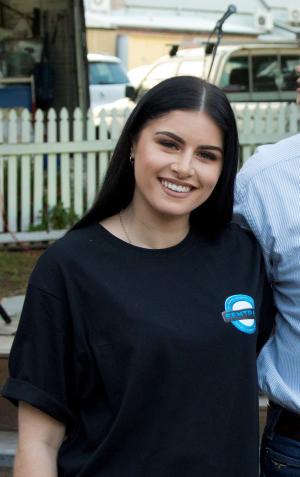 Ms Curran, who earned a Certificate IV in Mental Health and a Diploma of Counselling at TAFE NSW Wollongong, said the program played a critical role in helping local youth navigate the challenging emotional terrain of adolescence.
Ms Curran, who earned a Certificate IV in Mental Health and a Diploma of Counselling at TAFE NSW Wollongong, said the program played a critical role in helping local youth navigate the challenging emotional terrain of adolescence.
Communities across the South Coast have been deeply impacted by a number of youth suicides in recent months, an issue Kiama Municipal Council, through SENTRAL Youth Services, is aiming to support the community in addressing.
“It’s a very difficult time to be a young person,” Ms Curran said.
Rubi encourages young people to check in with their own mental health but also that of their friends. “Asking if someone is ok is really important but it’s also important to encourage someone to seek professional help should the answer to that question be ‘no’ or if you notice changes, even small changes, in people.” This is one of the skills that Rubi coaches young people in during the Empower with Rubi program.
The Empower with Rubi program is offered to selected Year 10 female students at Kiama High School and covers information on health and wellbeing, healthy relationships, sexual, drugs and alcohol and mental health.
“It’s about providing a safe space where participants feel supported, build confidence and ask questions they may not be able to ask at school,” Ms Curran said.
“To see how much these young women grow in that eight weeks is so rewarding and I try to be that older sister, that role model they may not have in their lives.”
Ms Curran’s former teacher and TAFE NSW Health, Wellbeing and Community Services Head of Skills Team, Anne Barrow, said as awareness grew about the importance of mental health, so too did job opportunities.
The Australian Government has forecast more than 50,000 job openings in the mental health field between 2018 and 2023, she said.
“Mental health is a growing area for job opportunities, especially in the current environment where there’s so much focus on it,” Ms Barrow said. “TAFE NSW provides the practical skills and experience for students to have a career in this richly rewarding area.”
Ms Barrow said TAFE NSW is offering a Diploma of Mental Health, a Certificate IV in Mental Health and a Diploma of Counselling for semester one, 2021.
To find out more about studying mental health at TAFE NSW, phone 13 16 01 or visit www.tafensw.edu.au.
Photo at right: Rubi Curran.
Four Indigenous composers and a piano from colonial times — making passionate, layered, honest music together
Christopher Sainsbury, Australian National University and Scott Davie, Australian National UniversityDespite having different cultural backgrounds and experiences — Indigenous composers with an Indigenous mentor, and a pianist descended from Anglo-colonial history — it is nevertheless possible to create a project that can serve as a focus for unification and strength.
In our instance, the trigger was a relic of the past. Specifically, an historical object made at a time of great significance for Australia: a square piano built around 1770, housed in the keyboard archives of the School of Music at ANU.
Its place of manufacture was Alsace in western Europe, a small body of land that has at times been claimed by Germany, at other times by France. The disputed nature of the territory serves as an ironic parallel to our project.
Given the historical importance of the time of manufacture — when James Cook was charting the eastern coast of Australia — we asked four Indigenous composers, all of whom have been through the Moogahlin Performing Arts and Ngarra-burria First Nations composers program, to write new music for the piano. The brief was simple: write something for the instrument, with the option of one other instrument or voice, to a length of around five minutes.
All four composers interpreted the project in thoroughly different ways, reflecting their unique artistic approaches and perhaps highlighting issues relating to previous attempts at addressing and improving the situation created by the past. Today, recordings of their works on Ngarra-burria Piyanna are being released for streaming and download.
The Instrument
The piano was built by Henri Henrion in a small village near to Sareguemines. Little is known about the builder, except that he eventually became involved in politics and got swept up in the events of the French Revolution.
Similar to other square pianos, including the instrument that came out on the First Fleet, it creates a sound that is far lighter than that of a modern piano.
From the outset, it was clear there could be challenges. It is undeniably confronting to ask people whose culture was so thoroughly subjugated to “get creative” with an object that could be seen as crucially symbolic of white history. It was joked that the creativity might take the form of matches and a chorus for a bonfire!
The compositions were recorded in Canberra last year, and were featured in a podcast broadcast on ABC radio, whose generous funding under the auspices of a Fresh Start Fund grant made it all possible.
Read more: It's time to properly acknowledge - and celebrate - Indigenous composers
From Rap To Gothic Vampires And Protest Songs
Rhyan Clapham, who works as a rapper with the pseudonym DOBBY, is the only composer who also performs their track, both on the square piano and vocals.
He set his goal as delivering a 250-year history of Australia, from the time the piano was made to the present. He enjoyed the process.
The team produced this unique project effectively and respectfully. There was a certain feeling shared by all of us that something quite special was happening.
The work by music student Elizabeth Sheppard, called Kalgoorli Silky Pear, draws on the history of her ancestors who resided in Western Australia generations before. It also incorporates an element of her Scottish lineage, through a hint of a lullaby towards the end. As a composer familiar with older musical styles, she has incorporated elements of Indigenous polyphony in a thoughtful way.
In Lupe’s Waltz, Tim Gray has imagined the pianist as a vampire. He has written a vocal line for a witch, all dreamed up in a gothic throwback to a Romanian grand ball. While we often look to Indigenous composers for cultural insights, there are less apparent metaphors in Tim’s music that may pass us by. This subtlety is part of the magic of the piece.
In writing about her work, The Binary, songwriter and storyteller Nardi Simpson (also a student at the School of Music) has been powerfully honest in recounting her initial reaction to the commission.
Read more: Together we rise: East Arnhem Land artists respond to COVID-19 with the gift of music
This piano — such a reminder of the horrors of colonisation for Indigenous peoples — was perhaps a foe and not a friend. So, ingeniously, Nardi took eight popular protest chants and coded them into complex rhythmic patterns. These then mingle and overlay. They create a transcendent and deeply meaningful musical landscape.
Rather than mask the sounds of the mechanical inner working of the instrument, the pieces were recorded with complete authenticity. In a sense, this decision stands as a symbol for the project: with honesty, authenticity, and a shared passion, music can show a way forward to a brighter future.
Read more: Terra nullius interruptus: Captain James Cook and absent presence in First Nations art ![]()
Christopher Sainsbury, Senior Lecturer Composition, Australian National University and Scott Davie, Lecturer in Piano, School of Music, Australian National University
This article is republished from The Conversation under a Creative Commons license. Read the original article.
To get ahead as an introvert, act like an extravert. It's not as hard as you think

Leadership is a human universal. It can even be seen in other species, which suggests it may be an evolutionarily ancient process.
A common personality trait of “natural” leaders is a higher than average level of extraversion. Research consistently shows extraverts, compared with introverts, are more likely to be regarded as leaders by others, and more likely to obtain leadership roles.
We decided to run an experiment to see if we could turn the leadership tables around by getting introverts to act like extraverts. We also wanted to find out how acting like an extravert makes introverts feel about themselves.
Our results show that introverts who act like extraverts are indeed viewed by others as having more leadership potential. We also found no evidence of psychological costs for introverts.
What We Know About Extraversion And Leadership
Before we get to the specifics of our research, let’s briefly recap the basic science of extraversion and leadership.
Extraversion is a continuum that measures the degree to which someone is enthusiastic, assertive and seeks out social interaction. It is typically included as part of the five-factor model of personality.
The other dimensions – or traits – in the five-factor model include openness (being intellectually curious and creative), conscientiousness (being orderly and industrious), agreeableness (being compassionate and polite), and neuroticism (being sensitive to experiencing negative emotions like anxiety, depression, and anger).
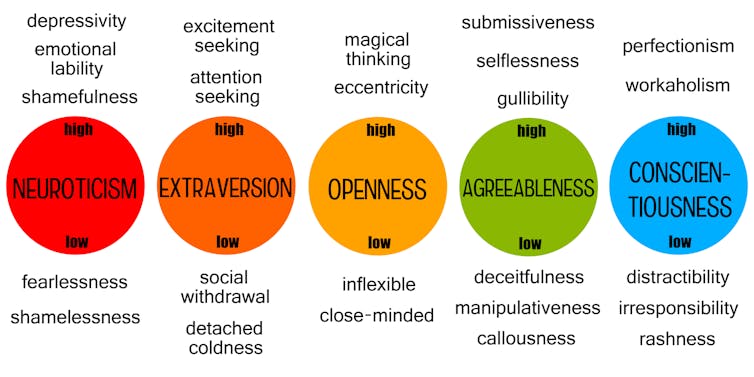
Extraversion has biological roots and is heritable. In others words, part of the reason we find differences in levels of extraversion between people is because there are genetic differences between people that partially determine our personality. Our genes even predict the likelihood we will occupy a leadership position.
We also know that extraverts have a more sensitive dopamine system in their brain. They are wired to find rewards more enticing. They crave social interaction and the attention that comes with it. This fact may partially explain why extraverts are more motivated to obtain leadership roles, given leadership is an inherently social process.
Read more: It's hard to find a humble CEO. Here's why
How We Did Our Experiment
Our experiment consisted of 601 participants randomly divided into 166 leaderless groups of typically four people.
We asked these groups to complete a 20-minute joint problem-solving activity (prioritising items needed to survive on the Moon). Participants were not told the purpose of the experiment.
We then split the groups into three “experimental conditions”.
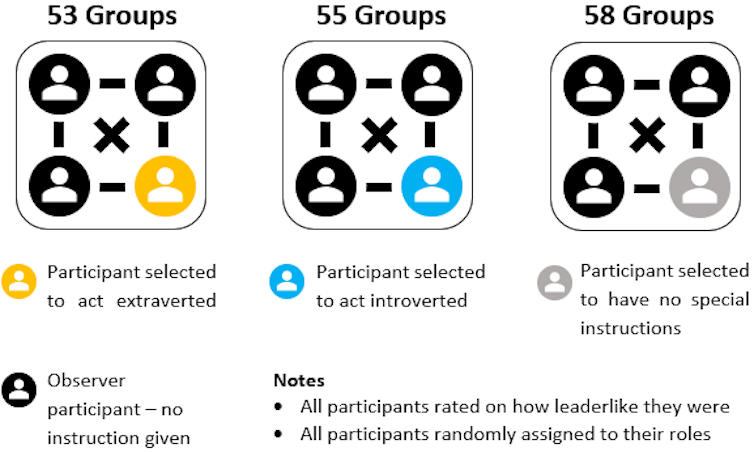
In the first (consisting of 53 groups) we randomly selected one person per group to act energetic, talkative, enthusiastic, bold, active, assertive and sociable – in other words, extraverted. These instructions were not known to other group members.
In the second (55 groups), the randomly chosen group member was secretly instructed to act quiet, reserved, lethargic, passive, compliant and unadventurous – in other words, introverted.
The third was our control condition with 58 groups, where no individual instructions were given.
At the of end the activity, participants rated the leadership quality of other group members (and themselves). They also rated how they felt.
We controlled for age, gender and other personality traits using a standard personality test. This ensured we isolated the true effect of extraverted and introverted behaviour.
Acting Like An Extravert Works
The first part of our results were unsurprising. Compared with participants in the control condition, those instructed to act extraverted were rated by others as having more leadership potential. Those instructed to act introverted were rated lower.
What was notable is that these ratings did not depend on “trait extraversion”. In other words, when instructed to act extraverted, both introverts and extraverts were rated higher on their leadership potential compared with an equivalently extraverted person in the control condition.
Equally, we found the participants instructed to act introverted were rated lower on their leadership potential compared with control participants.
But what was particularly interesting was these participants also rated themselves especially poorly on leadership ratings – worse than did their group members. Acting introverted had a particularly negative impact on how those individuals viewed their own leadership potential.
Read more: Why too many fearless people on a team make collaboration less likely
How Acting Out Of Character Felt
How our “actors” felt after the activity is shown in the next figure.
Compared with the control participants, there was no difference for those who acted extraverted. Even introverts felt perfectly OK after acting like extraverts.
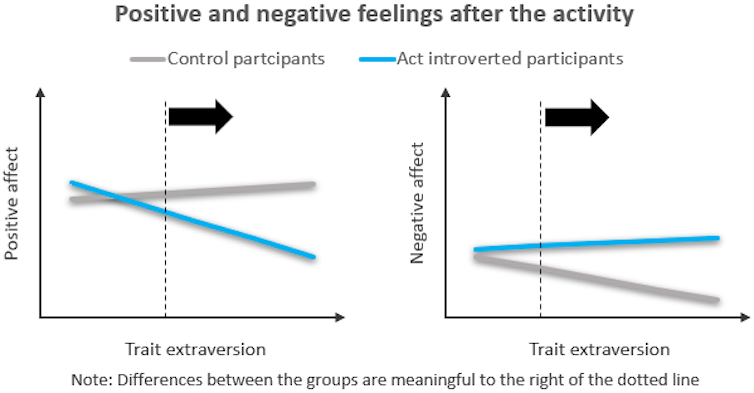
The extraverts who acted introverted were a different matter. They had fewer positive and more negative feelings compared with those in the control condition. In short, acting introverted made them feel bad.
Should Introverts Act Out Of Character To Get Ahead?
Our research shows introverts can effectively act out of character to obtain and succeed in leadership roles.
If you’re an introvert, you might feel you should not have to. But we suggest that being prepared to adapt your behaviour to the demands of a situation gives you an advantage over those who aren’t.
Nor is it as hard as you may think. Research shows introverts overestimate the unpleasantness and underestimate the “hedonic benefits” of acting extraverted. One study even suggests introverts feel more authentic when acting extraverted.
Read more: Introverts think they won't like being leaders but they are capable
Knowing extraverted behaviour is usually – though not always – enjoyable can help you feel more confident about “faking” extraverted behaviour in your own best interest.
So lead on – if you want.![]()
Andrew Spark, Postdoctoral research fellow, Queensland University of Technology and Peter O'Connor, Professor, Business and Management, Queensland University of Technology
This article is republished from The Conversation under a Creative Commons license. Read the original article.
Future cities: new challenges mean we need to reimagine the look of urban landscapes
Nick Dunn, Lancaster University and Paul Cureton, Lancaster UniversityImagining future cities has long been a favourite activity for architects, artists and designers. Technology is often central in these schemes – it appears as a dynamic and seemingly unstoppable force, providing a neat solution to society’s problems.
But our recent research has suggested that we need to significantly rethink the way we imagine future cities, and move our focus from an overarching technological vision to other priorities, such as environmental sustainability and the need to tackle social inequalities.
We need to answer questions about what can be sustained and what cannot, where cities can be located and where they cannot, and how we might travel in and between them.
The coronavirus pandemic has further reinforced this need. It has profoundly disrupted what we thought we knew about cities. It has further sharpened existing inequalities and brought about major challenges for how we physically live and work together.
The Future – Yesterday
The architect and influential urban planner Eugène Hénard was arguably the first to publicly discuss “future cities” in Europe during his 1910 address to the Royal Institute of British Architects in London. His vision anticipated the technological advances of the future, such as aerial transportation. This approach, prioritising technology, was also evoked in cinema in Fritz Lang’s 1927 film Metropolis.

It was also mirrored by architects such as Le Corbusier in projects such as the 1924 Ville Radieuse (The Radiant City). In this work, Le Corbusier developed his concept of the city as a symmetrical, regulated, and highly centralised landscape.
Such an approach can be traced through many subsequent visions for cities, portrayed as the physical embodiment of technological prowess.
A New Focus
But rather than simply focusing on technology to shape our future, we also need to look at it through social and global lenses. These alternative approaches are increasingly urgent. To provide a safe and sustainable world for present and future populations, we need to think beyond “solutionism”. This is the idea that every problem we have has a technological fix.
An identifiable shift in how future cities are being conceived, designed and delivered concerns the people involved in these processes. This ranges from localised projects to global initiatives. For example, the Every One Every Day project in Barking and Dagenham in London aims to make practical participation in neighbourhood projects inclusive and available to all residents. On a much wider scale, the New Urban Agenda global vision by the United Nations’ Habitat programme, meanwhile, calls for more inclusive and sustainable urbanisation and settlement planning.
We may want our future cities to prioritise environmental renewal. The Green Machine, a design for a future city by architect Stephane Malka, moves like a mobile oasis, replenishing desert rather than causing more environmental degradation. This future city collects water through air condensation and uses solar power to drive itself over arid landscapes.
These are ploughed and injected with a mixture of water, natural fertiliser and cereal seeds as it passes. Agricultural greenhouses along with livestock farms support the city’s inhabitants and supplement local populations. The project is scaleable and replicable in relation to the number of people needed to be accommodated.
Climate change brings with it the possibility of dramatic sea level rise. Post Carbon City-State, a project by architecture and urban design group Terreform, imagines a submerged New York. The project proposes that, rather than investing in mitigation efforts, the East and Hudson River are allowed to flood parts of Manhattan.
The new city is rebuilt in its surrounding rivers. Former streets become snaking arteries of liveable spaces, embedded with renewable energy resources, green vehicles, and productive nutrient zones. This replaces the current obsession with private car ownership towards more ecological forms of public transport.
Both these projects emphasise responses to the impacts of climate change over technological innovation for its own sake.
Alternatively, the cities of the future may prioritise equality. This is illustrated by spatial design agency 5th Studio’s Stour City, The Enabling State.
This is a future city for 60,000 inhabitants, envisioned along the River Stour and the Port of Harwich in East Anglia, England. Based around the urbanisation and intensification of existing rail and port infrastructure, it features initiatives such as waste to power generation in order to support a viable, low-impact city, with priorities including affordable housing for all.
Imagining these cities helps us understand how we want our future lives to look. But we must open up the opportunity to conceptualise these futures to a wider and more diverse set of people. By doing so, we will be better positioned to rethink the shifts required to safeguard our health, that of other species and the planet we share. This is the significance of visions for tomorrow’s world – and why we need to create new ones today.![]()
Nick Dunn, Professor of Urban Design, Lancaster University and Paul Cureton, Senior Lecturer in Design (People, Places, Products), Lancaster University
This article is republished from The Conversation under a Creative Commons license. Read the original article.
We found the oldest known cave painting of animals in a secret Indonesian valley

The dating of an exceptionally old cave painting of animals that was found recently on the Indonesian island of Sulawesi is reported in our paper out today.
The painting portrays images of the Sulawesi warty pig (Sus celebensis), which is a small (40-85kg) short-legged wild boar endemic to the island.
Dating to at least 45,500 years ago, this cave painting may be the oldest depiction of the animal world, and possibly the earliest figurative art (an image that resembles the thing it is intended to represent), yet uncovered.
Ice Age Art In Indonesia
Sulawesi is host to abundant cave art, the existence of which was first reported in the 1950s.
Read more: Indonesian cave paintings show the dawn of imaginative art and human spiritual belief
Until recently, the prevailing view was this art was the handiwork of Neolithic farmers who arrived around 4,000 years ago from southern China rather than the hunter-gatherers who had lived on Sulawesi for tens of thousands of years.
We now know that this is not correct.
In 2014, we reported the first dates for the South Sulawesi rock art.
Based on uranium-series analysis of mineral deposits (calcite) that formed naturally on the art we showed that a stencilled image of a human hand found in one cave was created at least 40,000 years ago. This is compatible in age with the famous ice age cave art in Europe.
Then, in 2019, we dated a spectacular painting at another cave that portrays hybrid human-animal figures hunting Sulawesi warty pigs and dwarf buffalos (anoas). This hunting scene is at least 43,900 years old and it features what may be the oldest depictions of supernatural beings.
In our latest study we push the age of Sulawesi’s rock art a little deeper into the past.
The Secret Valley
In December 2017 we conducted the first survey of an isolated valley set in mountainous terrain a stone’s throw from one of Indonesia’s largest cities, Makassar.
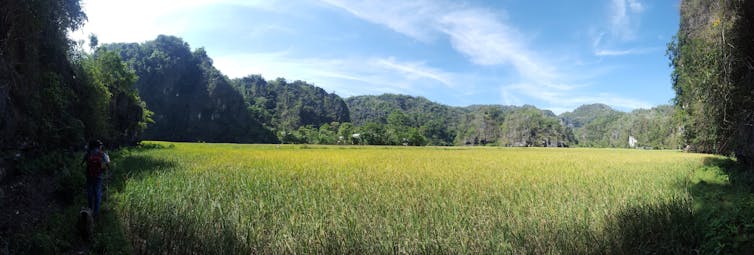
Despite its proximity to a major urban centre, there is no road to this valley. The small community of local Bugis farmers live a secluded existence, although they are widely reputed for the sublime quality (and potency) of their palm wine (ballo).
According to them no Westerner had ever set foot in their valley before.
This secret valley is a pristine environment and a place of resplendent natural beauty. There is hardly any rubbish in the tiny village in the centre of the valley. Being there feels like stepping back in time.
The valley harbours a limestone cave known as Leang Tedongnge and inside it we found a rock painting the locals claimed they had never noticed before.
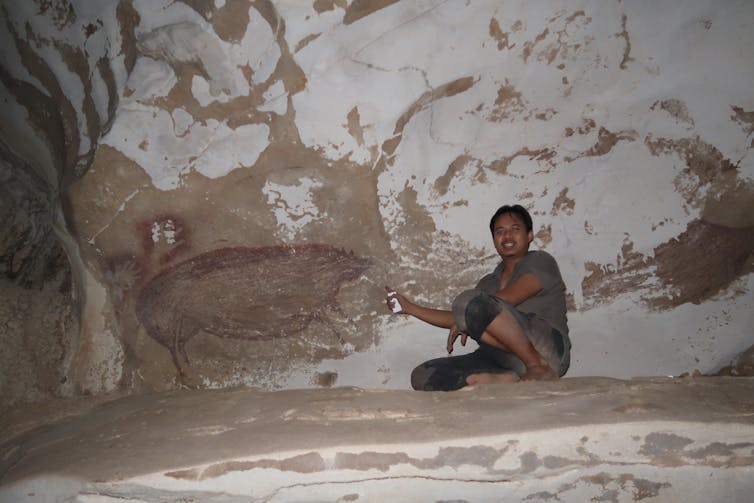
The painting was produced using a red mineral pigment (ironstone haematite, or ochre). It depicts at least three Sulawesi warty pigs engaged in social interaction of some kind.
We interpret the surviving elements of this artwork as a single narrative composition or scene, a mainstay of how we tell stories using images today but an uncommon feature of early cave art.

Unlocking The Age Of The Art
Dating rock art is very difficult at the best of times. But at Leang Tedongnge we were fortunate to identify a small calcite deposit (known as “cave popcorn”) that had formed on top of one of the pig figures (pig 1).
We sampled the calcite and analysed it for uranium-series dating. Amazingly, the dating work returned an age of 45,500 years ago for the calcite, meaning the painting on which it formed must be at least this old.
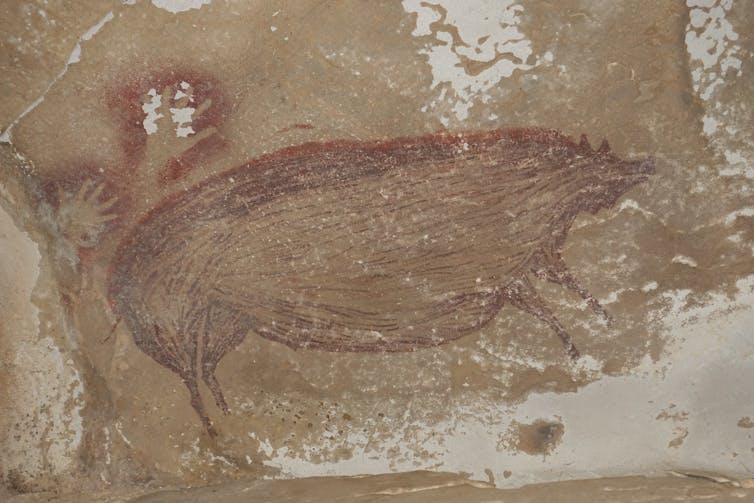
Early Art In Wallacea
Our discovery underlines the global importance of Sulawesi, and the wider Indonesian region, for our understanding of where and when the first cave art traditions developed by our species arose.
The great antiquity of this artwork also offers hints at the potential for other significant findings in this part of the world.
Sulawesi is the largest island in Wallacea, the zone of oceanic islands located between mainland Asia and the ice age continental landmass of Australia-New Guinea.
Read more: First pocket-sized artworks from Ice Age Indonesia show humanity's ancient drive to decorate
Modern humans are said to have crossed through Wallacea by watercraft at least 65,000 years ago in order to reach Australia by that time.
But the Wallacean islands are poorly explored and presently the earliest excavated archaeological evidence from this region is much younger.
We believe further research will uncover much older rock art in Sulawesi or on other Wallacean islands, dating back at least 65,000 years and possibly earlier.![]()
Adam Brumm, Professor, Griffith University; Adhi Oktaviana, PhD Candidate, Griffith University; Basran Burhan, PhD candidate, Griffith University, and Maxime Aubert, Professor, Griffith University
This article is republished from The Conversation under a Creative Commons license. Read the original article.
Ammonite: the remarkable real science of Mary Anning and her fossils
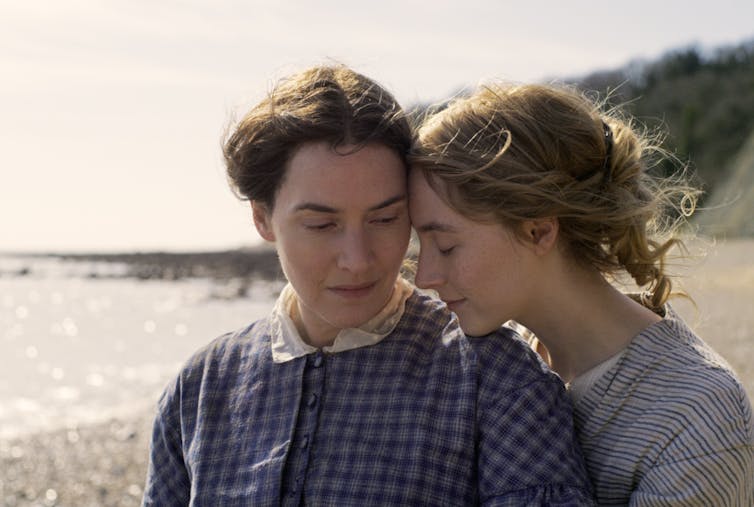
This story contains spoilers for Ammonite
Palaeontologist Mary Anning is known for discovering a multitude of Jurassic fossils from Lyme Regis on England’s Dorset Coast from the age of ten in 1809.
Her discoveries included the first complete Icthyosaurus (although it was her little brother who first stumbled across the skull, Anning spent the next year excavating and preparing the rest of the fossil), the first complete Plesiosaurus and subsequent plesiosaur species, a perfectly preserved belemnite complete with anterior sheath and inkbag, and the first pterodactyl Dimorphodon.
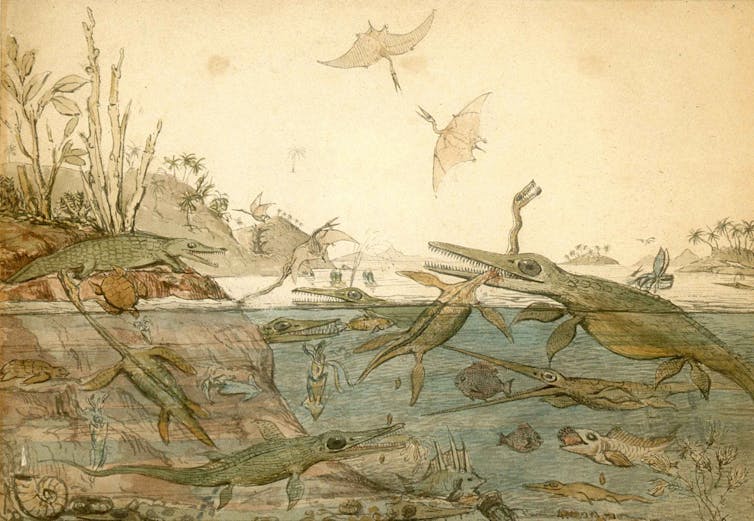
Her fossil finds were sought out by the “rockstar” palaeontologists of the day such as William Buckland and Richard Owen as they debated the age of the Earth, theories of extinction and, later, of evolution.
Although she died in 1847 at the age of 47, her impact on our understanding of the diversity of marine life in the Jurassic seas has left an indelible legacy.
True Tales And Tall Tales
The new film Ammonite — named for the whorl-shelled cephalopod fossil commonly found in Lyme Regis and sold as a “curios” in Anning’s time — is a fictionalised sensual love story between Anning (Kate Winslet) and her friend and fossicking partner Charlotte Murchison (Saoirse Ronan).
Since news of this film broke, there has been much discussion as to Mary Anning’s true sexual orientation. Depicted as a lesbian, the film’s writer and director, Francis Lee, has defended this choice by stating Ammonite is not a biopic.
While it is true Anning never married, and may have had a passionate love affair as shown in the film, I was curious as to how scientifically and historically accurate other details in the film were.
Ammonite begins in the 1840s, with Anning fossicking along the Lyme Regis coast, living in poverty with her mother (to whom she barely speaks) at the back of their family shop, Anning’s Fossils and Curios.
In reality, Anning sold fossils from a shop called Anning’s Fossil Depot she purchased at the age of 27. Prior to that, she sold fossils alongside her brother Joseph and mother Molly outside their family home.
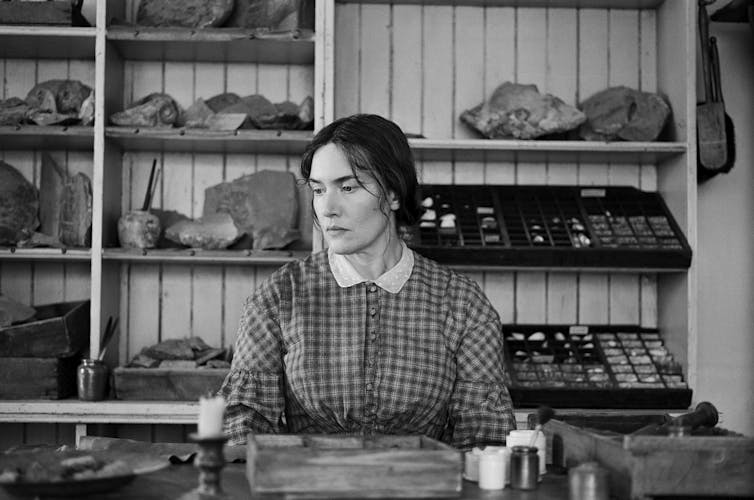
Anning and Murchison were firm friends in real life, and did indeed meet when Murchison’s geologist husband, Roderick, introduced them in Lyme Regis. But while the film depicts Murchison as a younger, helpless, melancholic wife, Murchison was Anning’s senior and a geologist in her own right.
Murchison was friends with other scientists including Mary Somerville (the first person to be called a “scientist”, rather than “man of science”). She worked alongside her husband on various geological field trips, and demanded the right to attend geological lectures at King’s College, London.
It is unfortunate that, in telling this story of one female scientist, the film diminishes the complexity and success of another. I wish Ronan’s Murchison had been given the chance to be depicted as the passionate geologist she truly was.
Read more: Radioactive: new Marie Curie biopic inspires, but resonates uneasily for women in science
For The Love Of Science
Anning’s life — both in fiction and reality — was centred around searching the coastline for fossils to sell.
The film version of Anning discusses and dismisses what her fossicking partner has found, including limestone (relatively fossil poor in that region of the world), calcite crystals, and the ammonites found in abundance: all accurate for the geology of the Blue Lias.
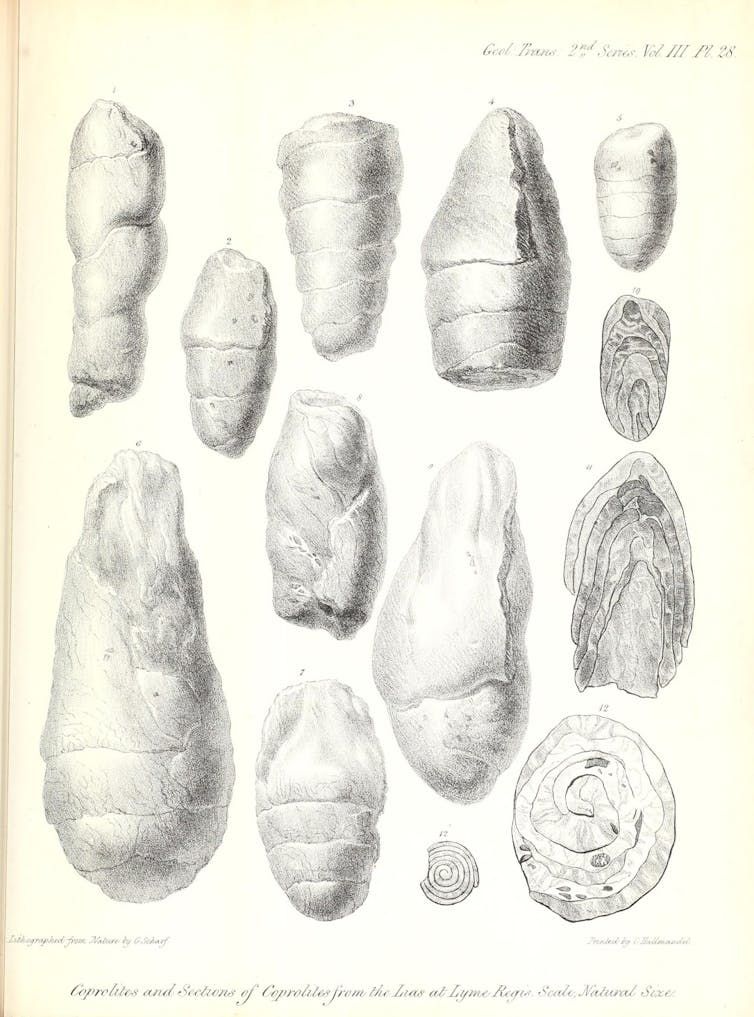
She only pauses when examining a coprolite, a nice nod to the fact Anning was the first to correctly identify what were known as “bezoar stones” as fossilised faeces.
The film also accurately depicts the nature and dangers of the Dorset Coast. Landslides were and are common, revealing new fossil finds at the risk of injury or death.
Although not depicted in the film, Anning lost her pet dog Tray to a landslide in 1833. She wrote to Murchison:
Perhaps you will laugh when I say that the death of my old faithful dog quite upset me, the cliff fell upon him and killed him in a moment before my eyes, and close to my feet, it was but a moment between me and the same fate.
Anning, sensitively played by Winslet, is a woman in poverty, who collects, prepares and sells fossils to survive — but treasures them nonetheless.
When given the opportunity to either live in comfort with Murchison and continue their relationship in secret, or return to a life of fossicking the treacherous Dorset coast, she chooses the latter.
Truth, openness and the freedom of finding fossils are more important to Anning than a closeted relationship with the woman of her dreams.

Unfortunately, while Ammonite — even with its liberties with the known facts — offers us an opportunity to reflect on the true story of this remarkable woman, Lee’s film is somewhat lumbering and poorly paced.
But through all of this, Winslet’s Anning is not a dispassionate scientist. She is a complex character who has suffered through poverty, loneliness and dismissal, and fiercely guards the life she has built for herself.
Ammonite is in cinemas now.![]()
Caitlin Syme, PhD in Vertebrate Palaeontology, The University of Queensland
This article is republished from The Conversation under a Creative Commons license. Read the original article.
Young people remain ill-equipped to participate in Australian democracy
Zareh Ghazarian, Monash University; Jacqueline Laughland-Booy, Australian Catholic University, and Zlatko Skrbis, Australian Catholic UniversityDespite many young Australians having a deep interest in political issues, most teenagers have a limited understanding about their nation’s democratic system.
Results from the 2019 National Assessment Program – Civics and Citizenship (NAP-CC) released today show the proportion of young people demonstrating the expected level of knowledge about topics such as democracy and government has not improved since three years ago.
Read more: 3 ways to help children think critically about the news
Only 38% of year 10 students reached the standard of knowledge on civics and citizenship required for their year level in 2019, the same percentage as in 2016. In year 6, 53% achieved the benchmark, which is down from 55% in 2016.
This has implications for the confidence and preparedness of young people to participate in shaping society now, and into the future.
What Is The Civics And Citizenship Test?
The national assessment program on civics and citizenship has been held every three years since 2004. It is administered to a sample of year 6 and year 10 students across Australia. Around 13,250 students sat the assessments in 2019.
The NAP-CC seeks to assess students’ understanding of topics including Australian politics, government, history and the legal system. It also captures students’ knowledge of their rights and responsibilities as citizens.
The NAP-CC aligns with educational aims agreed to by national, state and territory education ministers.
The Alice Springs (Mparntwe) Education Declaration, established in 2019, has two goals, the second of which is that:
young Australians become confident and creative individuals, successful lifelong learners, and active and informed members of the community.
What Do The Latest Results Show?
For year 6 students, the proficiency standard expects they can demonstrate knowledge of core aspects of Australian democracy. This includes awareness of the connection between fundamental principles (such as fairness) and their manifestation in rules and laws. They should also be able to demonstrate awareness of citizenship rights and responsibilities.
For example, students in year 6 should be able to identify the role of the prime minister, understand the origins of the Westminster system, and recognise that a vote on a proposed change to the constitution is a referendum.
At year 6, the percentage of students achieving the proficient standard has fallen slightly to 53% from 55% in 2016. This result maintains the established pattern where, since 2004, the percentage of year 6 students meeting the proficient standard has remained within the 50-55% range.
Read more: Schools are not adequately preparing young Australians to participate in our democracy
To meet the proficiency standards in year 10, students should be able to demonstrate knowledge of specific details of Australian democracy, make connections between the processes and outcomes of civil and civic institutions, and demonstrate awareness of the common good as a potential motivation for civic action.
Only 38% of year 10 students reached the proficient standard in 2019. This is the same as the last testing round in 2016, but well down on the 49% high achieved in 2010.
The NAP-CC 2019 results also showed:
at both year levels, female students outperformed males
there were large statistically significant differences between the achievements of non-Indigenous and Indigenous students
students with parents who were senior managers or professionals had significantly higher scores than students with parents who were classified as unskilled labourers, or office, sales or service staff
the scores of students from metropolitan schools were significantly higher than those of students from regional and remote schools at both year levels
students who had a parent with a bachelor’s degree or above achieved more than 130 scale points (one proficiency level) higher than students whose parents completed year 10 or year 9 as their highest level of education.
What We Need To Do
Year 10 is the last year of compulsory schooling in Australia. It is also the final year in which the national civics and citizenship curriculum is delivered.
This means year 10 can be the last opportunity for students to learn about their nation’s political system and their responsibilities as citizens.
Previous research has also shown young people would like to consolidate their knowledge about Australia’s democracy before leaving school.
A national civics and citizenship curriculum was developed by the Australian Curriculum, Assessment and Reporting Authority in 2012-2013. But states retain the constitutional authority over education, which results in variation in how civics and citizenship is taught across jurisdictions.
The latest data suggests now is the time to build on these investments and introduce targeted strategies.
When we spoke to school leavers in 2017, many told us they wanted additional lessons that concentrated on building their understanding of Australian democracy before they left school. In light of the consistently low performance at the year 10 level, it is now the time to capture and respond to the student voice.
Read more: Ignoring young people's climate change fears is a recipe for anxiety
We also need to support teachers. Young Australians have said what they learn at school about civics and citizenship is highly dependent on the preparedness of their teachers.
Teachers who are confident about exploring politics and government in class can have a positive impact on the learning outcomes of their students.
In what is often seen to be a “crowded curriculum”, teachers confront a range of challenges in delivering civics and citizenship lessons. As a result, there is value in providing opportunities to build their confidence and capacity in this space.
These latest figures show the previous results were no mere aberration and that student performance in civics and citizenship has remained low. The steps we take now will have an impact on Australian democracy for years to come.![]()
Zareh Ghazarian, Senior Lecturer, School of Social Sciences, Monash University; Jacqueline Laughland-Booy, Senior Advisor ( Research and Communications), Australian Catholic University, and Zlatko Skrbis, Vice-Chancellor and President, Australian Catholic University
This article is republished from The Conversation under a Creative Commons license. Read the original article.
Web's inventor says news media bargaining code could break the internet. He's right — but there's a fix
Tama Leaver, Curtin UniversityThe inventor of the World Wide Web, Tim Berners-Lee, has raised concerns that Australia’s proposed News Media and Digital Platforms Mandatory Bargaining Code could fundamentally break the internet as we know it.
His concerns are valid. However, they could be addressed through minor changes to the proposed code.
How Could The Code Break The Web?
The news media bargaining code aims to level the playing field between media companies and online giants. It would do this by forcing Facebook and Google to pay Australian news businesses for content linked to, or featured, on their platforms.
In a submission to the Senate inquiry about the code, Berners-Lee wrote:
Specifically, I am concerned that the Code risks breaching a fundamental principle of the web by requiring payment for linking between certain content online. […] The ability to link freely — meaning without limitations regarding the content of the linked site and without monetary fees — is fundamental to how the web operates.
Currently, one of the most basic underlying principles of the web is there is no cost involved in creating a hypertext link (or simply a “link”) to any other page or object online.
When Berners-Lee first devised the World Wide Web in 1989, he effectively gave away the idea and associated software for free, to ensure nobody would or could charge for using its protocols.
He argues the news media bargaining code could set a legal precedent allowing someone to charge for linking, which would let the genie out of the bottle — and plenty more attempts to charge for linking to content would appear.
If the precedent were set that people could be charged for simply linking to content online, it’s possible the underlying principle of linking would be disrupted.
As a result, there would likely be many attempts by both legitimate companies and scammers to charge users for what is currently free.
While supporting the “right of publishers and content creators to be properly rewarded for their work”, Berners-Lee asks the code be amended to maintain the principle of allowing free linking between content.
Google And Facebook Don’t Just Link To Content
Part of the issue here is Google and Facebook don’t just collect a list of interesting links to news content. Rather the way they find, sort, curate and present news content adds value for their users.
They don’t just link to news content, they reframe it. It is often in that reframing that advertisements appear, and this is where these platforms make money.
For example, this link will take you to the original 1989 proposal for the World Wide Web. Right now, anyone can create such a link to any other page or object on the web, without having to pay anyone else.
But what Facebook and Google do in curating news content is fundamentally different. They create compelling previews, usually by offering the headline of a news article, sometimes the first few lines, and often the first image extracted.
For instance, here is a preview Google generates when someone searches for Tim Berners-Lee’s Web proposal:

Evidently, what Google returns is more of a media-rich, detailed preview than a simple link. For Google’s users, this is a much more meaningful preview of the content and better enables them to decide whether they’ll click through to see more.
Another huge challenge for media businesses is that increasing numbers of users are taking headlines and previews at face value, without necessarily reading the article.
This can obviously decrease revenue for news providers, as well as perpetuate misinformation. Indeed, it’s one of the reasons Twitter began asking users to actually read content before retweeting it.
A fairly compelling argument, then, is that Google and Facebook add value for consumers via the reframing, curating and previewing of content — not just by linking to it.
Can The Code Be Fixed?
Currently in the code, the section concerning how platforms are “Making content available” lists three ways content is shared:
- content is reproduced on the service
- content is linked to
- an extract or preview is made available.
Similar terms are used to detail how users might interact with content.
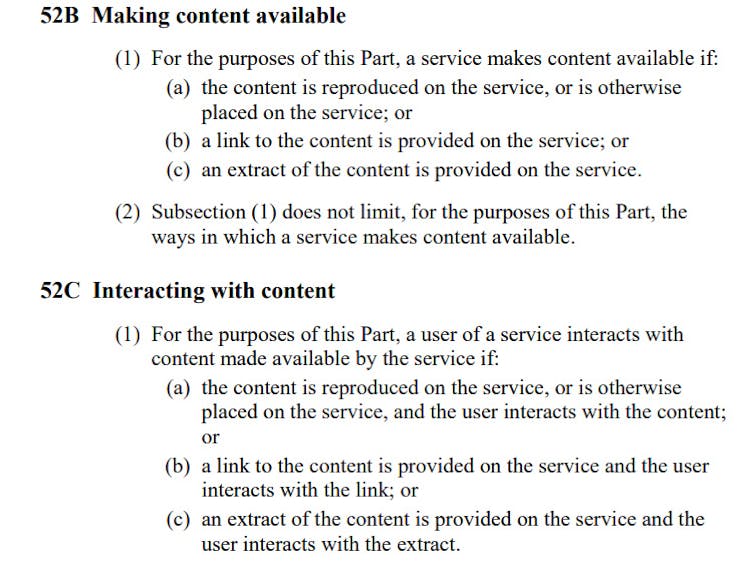
If we accept most of the additional value platforms provide to their users is in curating and providing previews of content, then deleting the second element (which just specifies linking to content) would fix Berners-Lee’s concerns.
It would ensure the use of links alone can’t be monetised, as has always been true on the web. Platforms would still need to pay when they present users with extracts or previews of articles, but not when they only link to it.
Since basic links are not the bread and butter of big platforms, this change wouldn’t fundamentally alter the purpose or principle of creating a more level playing field for news businesses and platforms.
In its current form, the News Media and Digital Platforms Mandatory Bargaining Code could put the underlying principles of the world wide web in jeopardy. Tim Berners-Lee is right to raise this point.
But a relatively small tweak to the code would prevent this, It would allow us to focus more on where big platforms actually provide value for users, and where the clearest justification lies in asking them to pay for news content.
For transparency, it should be noted The Conversation has also made a submission to the Senate inquiry regarding the News Media and Digital Platforms Mandatory Bargaining Code.![]()
Tama Leaver, Professor of Internet Studies, Curtin University
This article is republished from The Conversation under a Creative Commons license. Read the original article.
New State Library Of NSW Exhibition Showcases Defining Images Of 2020
Joe Biden sends a clear message to the watching world – America’s back
Scott Lucas, University of BirminghamPolitics doesn’t have to be a raging fire destroying everything in its path
Two weeks after the storming of the US Capitol by the followers of his predecessor, in the middle of an out-of-control pandemic that has killed more than 400,000 Americans, Joe Biden — the 46th president of the US — tried to contain the blaze in his inaugural address.
As aspiration, the speech was pitch perfect. Biden rightly took on the present of America’s most serious domestic crisis since the Civil War. Coronavirus, the Capitol attack, economic loss, immigration, climate change and social injustice were confronted:
We’ll press forward with speed and urgency for we have much to do in this winter of peril and significant possibility. Much to do, much to heal, much to restore, much to build and much to gain.
But what distinguished the speech beyond the essential was the sincerity with which it was delivered. Since the election, there has been a commingling of Biden’s personal narrative of loss with the damage that America has suffered. When he spoke of the “empty chair” and relatives who have died, it was from the heart and not just the script.
So, as he said in front of the Capitol: “My whole soul is in this”, there was no doubt — in contrast to the statements of his predecessor — that it is.
Complementing Biden’s rhetoric are the executive orders and legislation set out in the days before the inauguration. Immigration reform will be accompanied by protection of almost 800,000 young Dreamers from deportation. There is a mandate to reunite children separated from parents and a path to citizenship for millions of undocumented immigrants.
The US has rejoined the Paris Accords on climate change. The “Muslim Ban” is rescinded, Donald Trump’s wall with Mexico suspended. And coronavirus will finally be confronted with coordination between the federal, state and local governments and a US$1.9 trillion “American Rescue Plan”.
Words To A Waiting World
But where is America in the world in all this? In Biden’s attention to domestic crises, there was little beyond his intention to re-engage with the world on climate and reverse the previous administration’s myopic immigration measures. Even the invocations of American greatness, with one exception, stayed within its borders:
Through a crucible for the ages, America has been tested anew and America has risen to the challenge.
There is historical precedent for the exclusive focus on home. In 1933, as the Great Depression raged, Franklin Delano Roosevelt also made no reference to the world as he said at his first inauguration:
The only thing we have to fear is fear itself.
Perhaps even more pertinently, in 1865, Abraham Lincoln said in his second inaugural address, a month before his assassination and two months before the end of the Civil War:
With malice toward none; with charity for all; with firmness in the right, as God gives us to see the right, let us strive on to finish the work we are in; to bind up the nation’s wounds.
Beyond the inaugural, there are clues in Biden’s appointment of Obama-era pragmatists: Antony Blinken as secretary of state, Jake Sullivan as national security advisor, John Kerry in a special post for climate change. There will be no sweeping “Biden Doctrine”, nor a grand speech such as Barack Obama’s in Cairo or Ankara in 2009.
Instead, the pragmatists will try to restore alliances, reestablish the “rules of the game” with countries such as China, Russia and North Korea — and work case-by-case on immediate issues such as the Iran nuclear deal.
Read more: Who’s who in Joe Biden’s cabinet
But for this day, and for the weeks and months to come, the foreign challenges will primarily be an extension of the domestic issues that Biden set out on “America’s day … democracy’s day”.
Recovery of America’s damaged standing will come from success in putting out the fires that are not just in the US: saving lives and vanquishing a virus, committing to a secure environment, tackling the inequities and divisions in the way of justice for all.
For as the world watched, Biden’s exceptional reference to an aspiration beyond the US came in his penultimate paragraph about the “American story” to be written:
That America secured liberty at home and stood once again as a beacon to the world. That is what we owe our forebears, one another, and generations to follow.
Scott Lucas, Professor of International Politics, University of Birmingham
This article is republished from The Conversation under a Creative Commons license. Read the original article.
Starfish: rare fossil helps answer the mystery of how they evolved arms
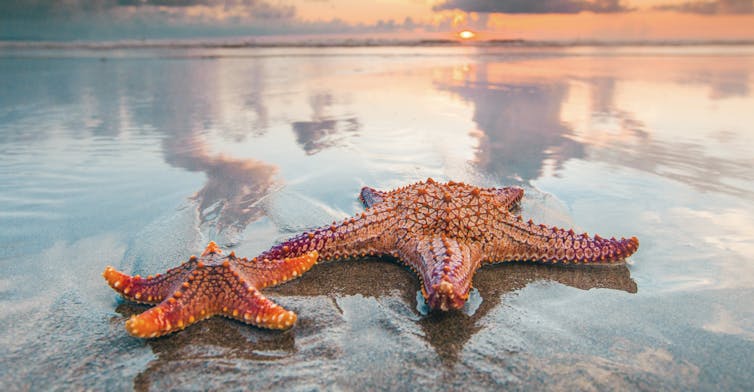
A chance discovery of a beautifully preserved fossil in the desert landscape of Morocco has solved one of the great mysteries of biology and palaeontology: how starfish evolved their arms.
Starfish are one of the most recognisable animals on our planet. Most people probably associate them with trips to the beach, walking in rock pools or swimming in the sea. They might appear simple creatures, but the way these animals’ distinctive biology evolved was, until recently, unknown.
Our new study, published in the journal Biology Letters, sheds light on how the starfish developed its distinctive shape.
The Mystery Of Starfish
Starfish, and their close relatives the brittle stars, belong to a group called the echinoderms. These are animals with spiny skins, including sea urchins, sea lilies and sea cucumbers, with bizarre biological traits. They have no head or a brain, and have a unique circulatory system called a water vascular system, which uses seawater instead of blood. They even possess the power to regenerate over 75% of their body mass if it is lost.
Starfish have almost always had the same five-armed body shape. This has not changed for almost 480 million years, throughout the five great mass extinctions they survived.
Other echinoderms use their arms to filter feed or catch food from the water and, unlike starfish, face upwards with their arms spreading outward to feed. But starfish do not, and their distinctive body shape appeared in the fossil record fully formed. So for years scientists have been perplexed by how it evolved and how starfish are related to their close relatives, the brittle stars.
The Pompeii Of Palaeontology
The Fezouata formations are sedimentary rock deposits in Morocco dating back to the early Ordovician period, a critical stage in the evolution of life, which ended around 460 million years ago. Palaeontologists think life rapidly diversified during this time, in an episode call the great Ordovician biodiversification event, when animals we might recognise today first appeared.
The Fezouata formations are a bit like the Pompeii of palaeontology. The conditions on the seabed meant even soft tissue, which would normally be destroyed over time, could be preserved. Because of this, the formations provide a window into what happened at a key moment in the history of life on Earth.
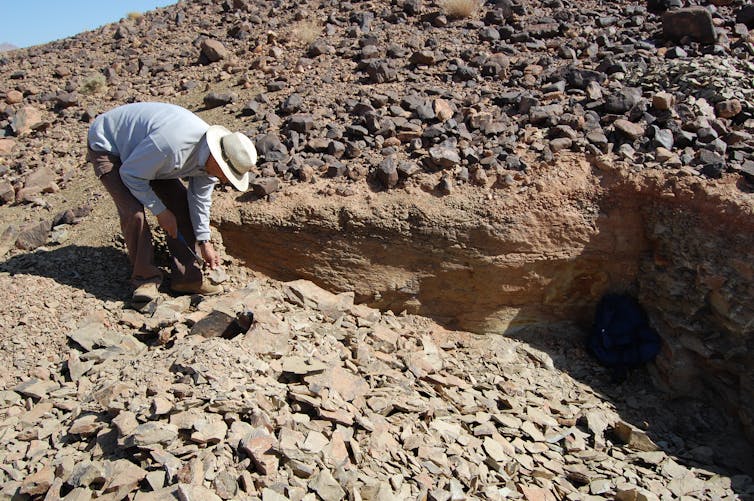
Although starfish might appear very robust animals, they are typically made up of lots of hard parts attached by ligaments and soft tissue which, upon death, quickly degrade. This means we rely on places like the Fezouata formations to provide snapshots of their evolution.
The starfish fossil record is patchy, especially at the critical time when many of these animal groups first appeared. Sorting out how each of the various types of ancient starfish relate to each other is like putting a puzzle together when many of the parts are missing.
The Oldest Starfish
Cantabrigiaster is the most primitive starfish-like animal to be discovered in the fossil record. It was discovered in 2003, but it has taken over 17 years to work out its true significance.
What makes Cantabrigiaster unique is that it lacks almost all the characteristics we find in brittle stars and starfish.
Starfish and brittle stars belong to the family Asterozoa. Their ancestors, the Somasteroids were especially fragile - before Cantabrigiaster we only had a handful of specimens. The celebrated Moroccan palaeontologist Mohamed Ben Moula and his local team was instrumental in discovering these amazing fossils near the town of Zagora, in Morocco.
The Breakthrough
Our breakthrough moment came when I compared the arms of Cantabrigiaster with those of modern sea lilles, filter feeders with long feathery arms that tend to be attached to the sea floor by a stem or stalk.
The striking similarity between these modern filter feeders and the ancient starfish led our team from the University of Cambridge and Harvard University to create a new analysis. We applied a biological model to the features of all the current early Asterozoa fossils in existence, along with a sample of their closest relatives.
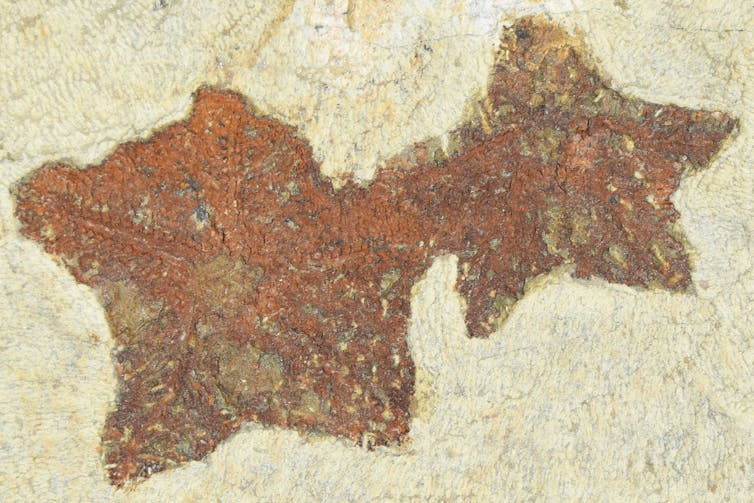
Our results demonstrate Cantabrigiaster is the most primitive of all the Asterozoa, and most likely evolved from ancient animals called crinoids that lived 250 million years before dinosaurs. The five arms of starfish are a relic left over from these ancestors. In the case of Cantabrigiaster, and its starfish descendants, it evolved by flipping upside-down so its arms are face down on the sediment to feed.
Although we sampled a relatively small numbers of those ancestors, one of the unexpected outcomes was it provided an idea of how they could be related to each other. Palaeontologists studying echinoderms are often lost in detail as all the different groups are so radically different from each other, so it is hard to tell which evolved first.![]()
Aaron W Hunter, Science Guide & Tutor, Dept. of Earth Sciences, University of Cambridge
This article is republished from The Conversation under a Creative Commons license. Read the original article.
Brain Pressure Disorder That Causes Headache And Vision Problems On Rise
Research Establishes Antibiotic Potential For Cannabis Molecule
New Discovery In Breast Cancer Treatment
Cosmic Beasts And Where To Find Them
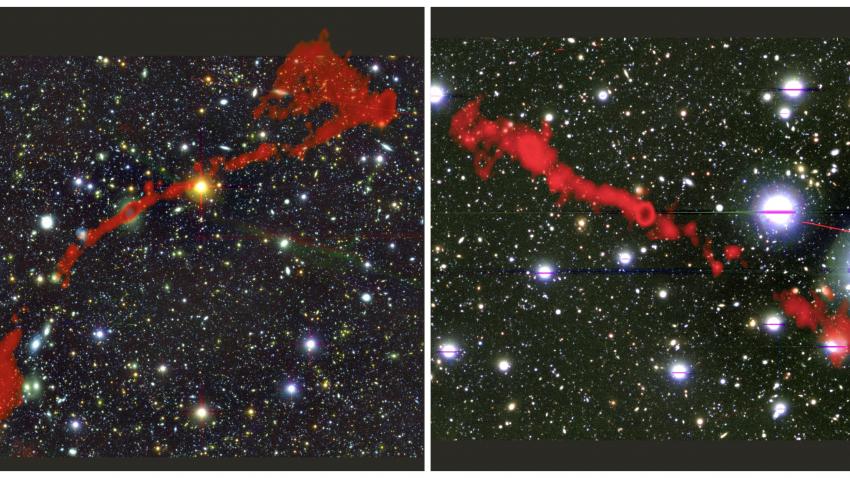
Disclaimer: These articles are not intended to provide medical advice, diagnosis or treatment. Views expressed here do not necessarily reflect those of Pittwater Online News or its staff.